#like this is of course the era 5 years prior to the events of the show
Text
The Power of Understanding / Pilot (Part 1 v2)
Rewritten to v2 on: 2023/09/10
Cheat Sheet
Read of Ao3
Chapters: Pilot, Part 2, Part 3, Part 4, Part 5, Part 6, Part 7, Part 8, Part 9
Summary: You have been with the Chain for a while now, as their "scholar" and translator. You know everything about them, because you are from our world. But do *they *know the truth about how you can understand everyone?
A little introduction and world building concept for the Translator!Reader and her adventures. Check notes below for more info!
Non-linear fic.
AU fic, prior to TotK (instead of TotK, chain events happen).
Loosely based on the same reader in my NSFW fic, which is a very loose prequel to this one, and a work in progress.
More background info to come, if I feel like it :D
Warnings: None, maybe some cussing, but nothing is censored. SFW content.
Points of interest: This is your thing if you are into the mystery of chain being able to talk to each other. I am an actual trained linguist IRL, hence this HAD to be written!
You were daydreaming in the middle of the day about him again, amidst the smell of horse shit around you, when you're supposed to be finishing the work you have until the end of the day. Or until a new portal pops up to swallow you all to Goddess knows which Hyrule this time. Damned black-blooded monsters. At least, this gave you some break.
You, coming from our own era, have been acting as the scholar of the Chain for the last couple of years, while hopping from world to world with them. Knowing this, Malon put you to work on the books of the ranch, instead of letting you deal with the cows or the horses, even though you really didn’t have anything specific to do with maths. You thought she was being kind to you, not letting you deal with dirty ranch work, you guessed? She was a sweetheart either way.
You wanted to hang out with Twilight at the same time, so instead of using the little study Malon offered, you took the books and went down to the stables. You continued with your own stuff, while he was taking care of the horses.
There was also this little thing: you were the only one who understood every single one of them, (almost) very clearly, comparatively speaking. Sure they could communicate without you just as well, but due to a bunch of coincidences, you were the closest thing to the “translation magic”, if you can call it that. Maybe it was your Hoshi Sato gene*. Maybe it was the fact that you actually stayed with Link & Zelda in the post-Calamity world, around two years prior meeting the Chain**, maybe a bit of magic was also involved. Hylia works in mysterious ways! Did it almost cost you your brain? Yes. Was it worth it? Absolutely.
Some Links, of course, understood each other better than the others, especially when their eras were, linguistically speaking, not that far. Time and Twilight were just fine. Legend and Hyrule were already able to understand each other, even a little bit better than Time and Twilight. Sky was a bit further away and had a “funny way of saying things” (according to the Sailor), almost gibberish, but when you listened and when he spoke slowly enough, you could at least get the gist of what he was trying to say. Wind, Time, and Warriors already knew each other from other “incidents” before the Chain, so they already had a way of communicating.
These worlds also did not have many invasions and wars by “outsiders”, if you don’t count things like the Triforce War, Imprisoning War, Sealing War, and of course, anything that had to do with Demise, Ganon & co. and their horrible reincarnations. This meant, not a lot of language change.
In the end, what happened was that over the two years you have been together with the group, you helped them understand each other better. They adjusted their accents, and somehow warped the Hylian they speak in a way that the group would understand (and especially you), when the dialogue was still within the group. Of course, the Old Man would speak more “naturally” with Malon and vice versa, and some of the chain would adjust better (e.g. Twilight or Smithy) to the language of the era they are in. After some point, communication was not that much of a problem. You learnt it all in the end.
Writing?
Funny enough, Wild, Sky, and Twilight had similar scripts. Time and Wind had more similar writing systems. Wild, Wars, Legend, Time, and Rulie were also better at understanding the scripts of their respective eras. Overall, other than a couple of hiccups, most understood the others’ script to an extent.
And then there was Wild. Also known as “The Cook” nowadays. The rest of the chain didn’t know you called them the Chain in your mind, and had your little nicknames for them. The nicknames most likely revealed a bit too much, and even though most of the secrets were out nowadays… You knew better than to risk more. You have caused enough damage, you would think sometimes. Even though you just couldn’t resist the urge.
Anyway… Wild, his case and communication issues… were complicated.
According to the rest of the chain when you guys first met, whatever he was saying (and vice versa) was almost complete gibberish at first. Some terms and special names like “deku,” “korok,” “Hylia,” “Hyrule,” “rupee,” and such were still there, albeit with a different accent, and they helped, but it was not enough. You only found out later that it was kind of… your fault.
In the end, he was also able to communicate with them just fine. Each Link had their own… language variation and accents, so to say. Some of them did not even have the difference enough to call it a “dialect” comparatively. As you thought, language change is a slow enough process, and with the lack of ‘conflicts’ (for lack of a better word) compared to your world, no wonder they were still somehow able to understand each other. .
The Goddesses work in mysterious ways indeed.
How did it work for you, though? There was this little secret that… First time around, when you first dropped into Wild's Hyrule, “Hylian” was basically a weird mesh-up of English and Japanese to your ears, after the enchantment from the Great Fairies you have received. It was “so you could slowly understand and grasp and communicate”, you were told.
Oh boy, it really felt like a genie granting you a wish, but in its own twisted way. You found that out later though.
Second time around when you first met the rest of Links, though? The first enchantment… kind of messed everything up. Second time around, you actually ended up learning real Hylian. At least, the Hylian that was used as a lingua franca between you guys.
Of course, some learning skill enchantment was definitely not out of the deal this time as well, thanks to Rulie & Time and their fairy friends, and of course the Smithy. But what a disaster it had been! Well, it wasn’t your fault that the first time the enchantment was made, nobody calculated that you would meet the Links from other eras.
You also naturally know the reason behind why Links in kind of irrelevant eras could decipher each other's texts, even when they didn’t understand the words all the time. Some were based on the Latin alphabet, and some were on Japanese kana. No way you could clearly explain it to them.
“Oh, by the way, you are made by a game company called Nintendo, and this guy is called Miyamoto…”
Yeah, no. That didn’t go well last time. Nobody even understood what you meant.
That was a battle to fight for another day… Now, you need to focus on the budget of the Lon Lon Ranch. And not be distracted by Twilight’s statue.
________________
Notes:
Fanciest and most OP translator you will ever know. Star Trek Universe.
"You” already spent three years with Link and Zelda in Wild’s world and were enchanted by the Great Fairies (with Zelda’s involvement) for the improvement of learning abilities.
#linked universe x reader#linked universe au#zelda fandom#zelda fanfiction#tloz au#fanfic#link x reader#twilight x reader#wild x reader#flora x reader#zelda x reader#ethical non monogamy#polyamory#linguistics#languages#translation#linked universe#legend of zelda#fluff#pilot chapter#isekai#isekai reader#the legend of zelda#botw link#botw#zelda botw#story concept#fanfic concept#lgbtq community#language
135 notes
·
View notes
Text
Cassandra Cain’s First Go Around as an Outsider...

So with Birds of Prey coming in September I think what best to hype that comic up is I’m gonna look at Cassandra’s other team outings (along with her history with the Birds of Prey).
I’ll start with this one because it’ll be a copy and paste from my Twitter thread on it years ago (but it does have a few updates to it). Plus I figure to get the worst one out of the way first aka Cass’s first outing as an Outsider. If no one doesn’t know this era OH BOY you’re in for a wild ride!
Now Batman & the Outsiders Vol. 2 #1 was a comic hyped for months literally prior to it's October launch (and a creative team locked in). You had one-shots in the summer with Batman testing which members would compliment his team and-- the creative team left the comic two months prior to the launch.
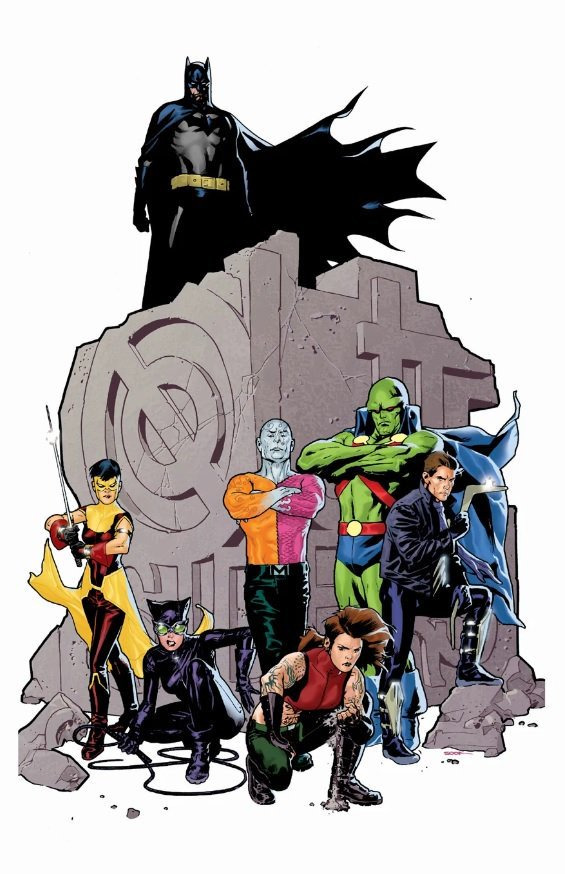
DC somehow kept the book to be released still ON TIME, but now with a new team both in members and in creative. Some of the original members were booted off into events going around at the time (Martian Manhunter and Catwoman to a Final Crisis prelude tie-in Salvation Run which would lead into poor J’onn’s death into that event and-- Boomer got shelved until Blackest Night event where he’d get eventually killed by his father who was giving him victims namely kids and women).
Geoforce, Green Arrow, Thunder, and Cass replaced them. As for the writer of this book? No worries I’ll get to that.

Again it still surprises me to this day how this comic wasn't delayed (like the next time Cass would join the team which kept it's original creative team THANKFULLY) after the original creative team left. They churned out issues instantly. Cass herself doesn't show up till the final page of #2.
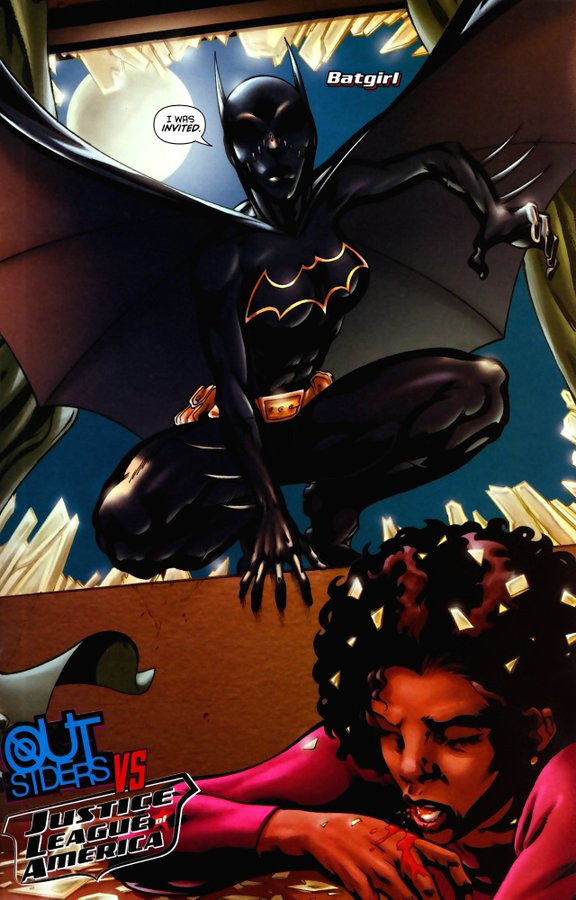
This section was recently referenced in the Other History of the DCU #5 when it focused on Thunder. Her opinion on Cass was totally opposite what we got in the run:


Now, for added context, the quack job that is Chuck Dixon was brought onto the Bat Family comics as basically a fixer. He was fixing Tim and bringing back Stephanie in Robin while here basically repairing the EVIL turn of Cass. During the summer that was teasing membership to the Outsiders, there was a Black Canary mini out as well and Cass’s status quo was what spurned the series (#1):

The ramifications of the mini had Dinah letting go her sword-sister/adopted daughter Sin and putting her in witness protection program to live with another family because League members wanted to turn Sin into Cass 2.0. The ramifications of this mini are why Ollie isn't a fan of Cass and solely blaming her for Dinah’s heartbreak (though it’s barely spelled out in the series itself).
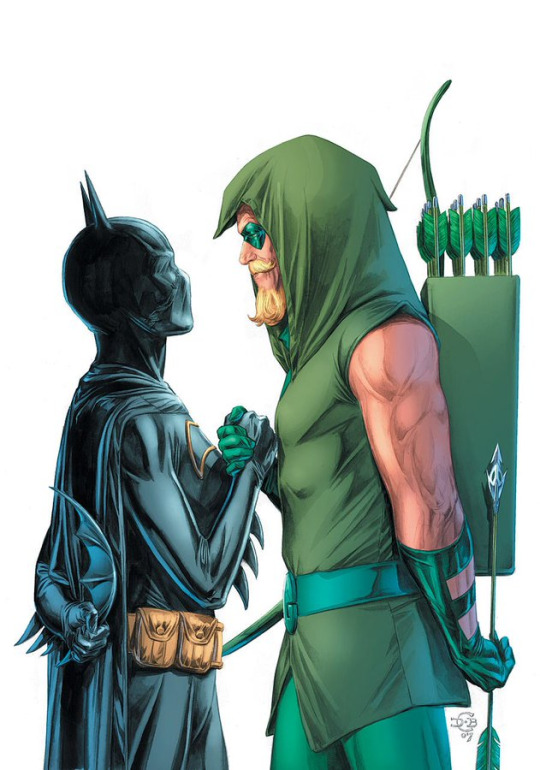
So with all that said onto what Cass did in the series.
I’ll start with what this run one of the infamous things remembered pertaining to Cass with this run. Aka #3 where Dixon uses her sexually as a slab of meat while also having artist Julian Lopez dish out additional cheese on Thunder and Grace (because of course). I’m not gonna post those to spare you from it however here’s Grace/Thunder’s reaction to Cass’s nude stroll in front of them:
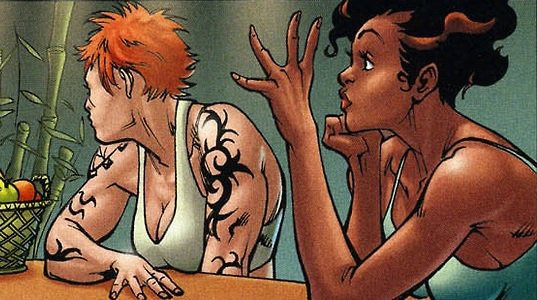
If there’s any positive that can come from this moment. It is exactly the first time an artist depicts Cass with scars on her body showing the abuse she endured because of her fucked up dad, David Cain.
The subplot with Ollie resolves in the next issue as #4 has him trying to kill Cass in front of everyone, but Katana then Batman intervene. As to why Bruce is suddenly so protective of Cass, Dixon intended to tell this in a filler issue of Tec of that angle (see my lost Cass tales here for more on that). As for Ollie/Cass...

They fight and well...

And that’s the end of Ollie’s beef with Cass (until later on when something new arises-- CAUSE REASONS).

#5 features more Cass but basically doing what she does best-- kicking ass. Though side-note, this series had some amazing covers that feature her. So, at least it's something.
As for the issue itself, she subdues a cloaked assassin. And that's basically it.

Another damn good cover with #6.
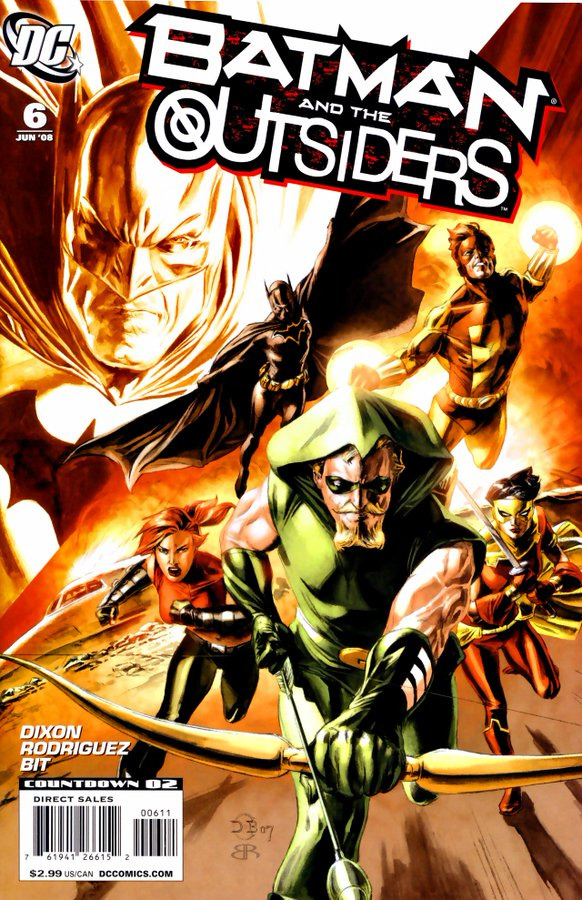
Cass appears throughout the issue (alongside Bruce), but has zero dialogue, Other than being one of two Outsiders not caught by the Chinese at issue's end (Geoforce is the other) in an attempt to rescue Metamorpho from space. She also makes sure to take care of Soultaker (Katana’s sword) when no one is looking too.

#7 is when Dixon finally teases us what he wants to do with Cass. As she breaks into the base and out of everyone captured pays Tatsu a visit.

#8 gives us the best Cass centric cover out of the bunch:
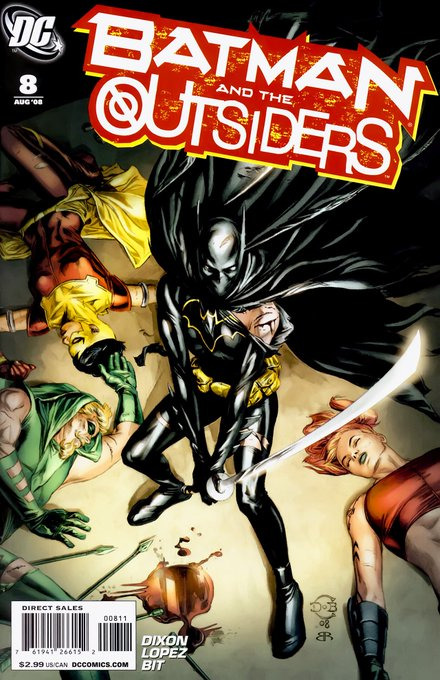
Cass jumps to the rescue of her captured comrades who are about to be shot to death. And her actual plan?

Basically, go out fighting. She had 0 contact from Bruce, Geoforce presumed dead. Is it OOC for Cass? You decide that. But Thunder, Nightwing (oh irony), and Remac (a repurposed modified OMAC) save the day getting all to safety.
#9 features Dixon's probable endgame, Tatsu's motherly instinct going off noting all stuff she's been thru with Cass thus far and knowing something is not right within her.
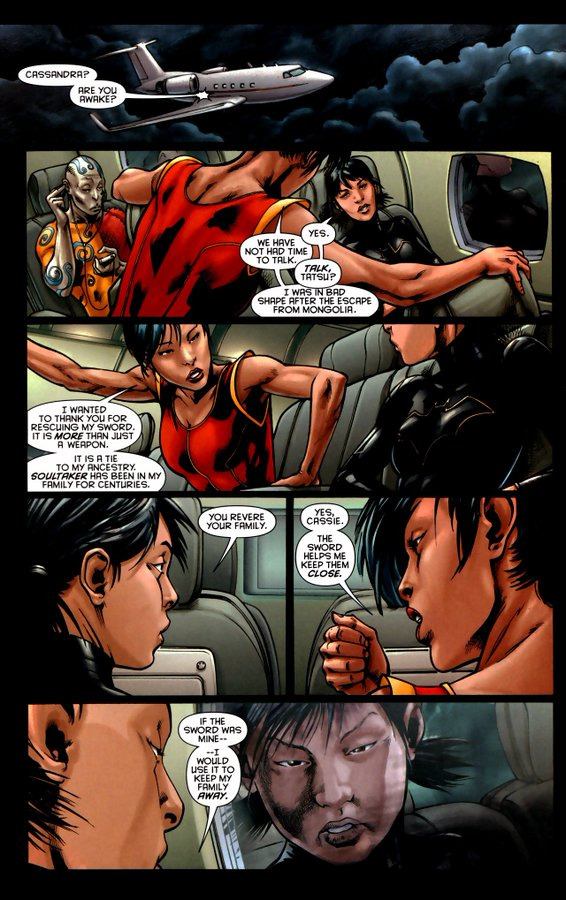
Intermission time. To talk more on the goings on OUTSIDE this book and look no further than to DC Nation end pages to these issues for inspiration to that. . ... Way to go there Dan.

So Batman R.I.P (and soon Final Crisis) was happening in the comics outside this book. As was the case with DiDio (as always) he left creators in the dark what was going on. So while Dixon was laying A LOT of subplots for his run here, Danny boy was plotting Cass being ousted from the Batgirl identity and putting Babs back in the role.
Dixon eventually walked away from this book with #10 (though Lopez left earlier in #9). Ryan Benjamin would take on art duties for the comics final issues.

Now hold onto your butts cause this is how Dixon writes Batman out of his book. The team is currently dealing with a black market group using an alien from the Bloodlines event (aka the event that gave us Hitman).

And this is how Bruce exits the comic completely riding a 90s creature telling Cass and everyone he must go now. Batman R.I.P. is calling him. Just soak in this page. Just take it all in.

And here is Dixon's final “gift” trying to make the team now into Batgirl & the Outsiders (because he had zero idea what was going on and decided this was the best direction to take it). The idea is sound given Cass is the literally an Outsider leading a team of them. I mean who wants to read that? Raise of hands? Exactly.
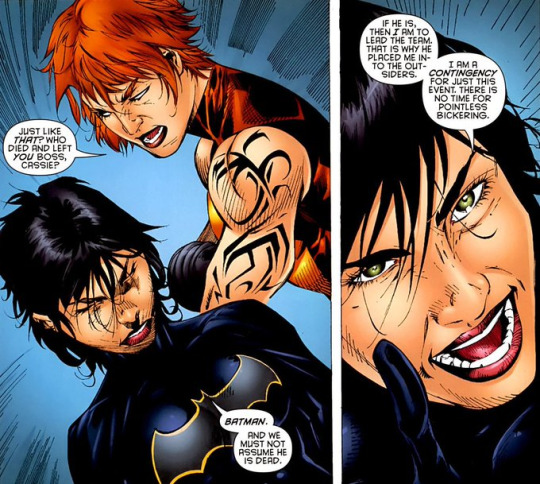
#11 and writer Frank Tieri comes on board to basically patch up the loose ends of this comic, and Batgirl Vol. 2.
At this point the comic basically becomes a stealth Cass ongoing. As she interrogates Penguin in front of all of Intergang (they took over the Gotham Underworld in Gotham Underground mini).

She also interrogates Jigsaw Johnny Stitches (the Intergang leader at the time). On the bright side, she is interrogating the entire criminal underworld for answers. It just seems beating up all of crime isn't getting any results.

The Outsiders do find a few answers as to Batman's disappearance when they visit Arkham, but-- if you read Batman R.I.P. this plot point makes 0 sense. Since the climax took place IN ARKHAM and the Joker went M.I.A. near the end of it.

#12 opens with a flashforward. An Outsider is dead, and Thunder is in a coma. Grace is at her beloved's side, and outside well is Cass. Things don't go so well.
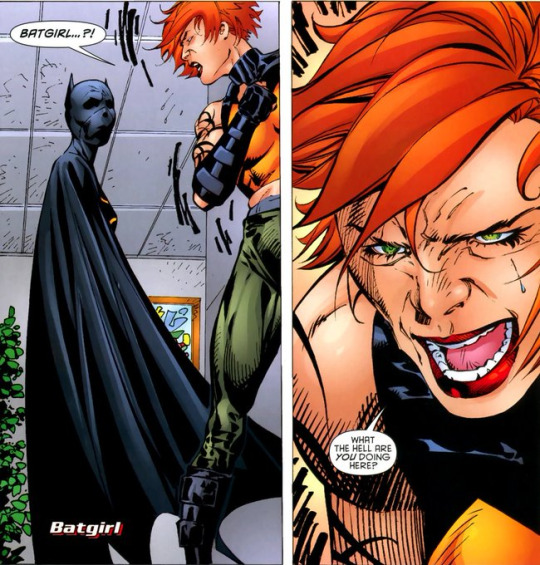
Basically, #11 ended with them finding a video of Batman alive greeting his team. #12 after the flashfoward picks up on the entire video with Bruce telling them he's also backed a code for Remac that'll teleport them all to his location. Ollie doesn't trust the video, while Cass.

Oliver is the only one who disagrees with the idea and leaves the team. Remac downloads the code goes nuts and explodes resulting in him dying, Thunder in a coma, and Rex blown to bits (but reforming slowly).
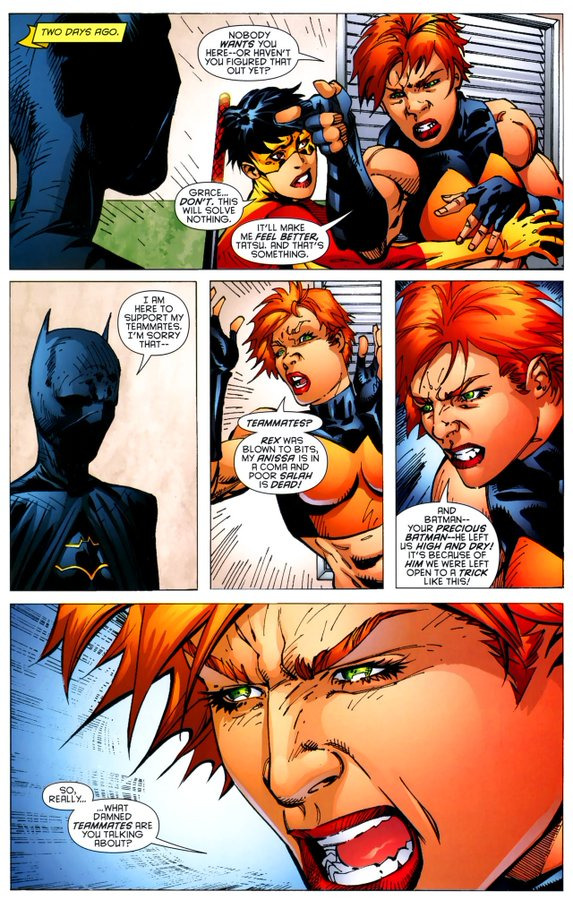
So Tatsu (WHY!? Why does she leave? Why doesn't she even get a say?) and Grace leave Cass with no Outsiders. At the funeral of all people Dr. Langstrom consuls Cassandra (cause reasons aka Tieri liked the character).


Afterward, Cass goes to Tim (who's looking fine actually even though if you read his arc well-- yeah. Things aren't going fine with him). Still, it's Tim/Cass being there for one another. That's something at least.

What Tim finds is a video from the Black Glove boasting of their plan to take out the Outsiders. Cass, on the other hand, responds in kindly. Well, at least Tieri is keeping Dixon's idea at least.
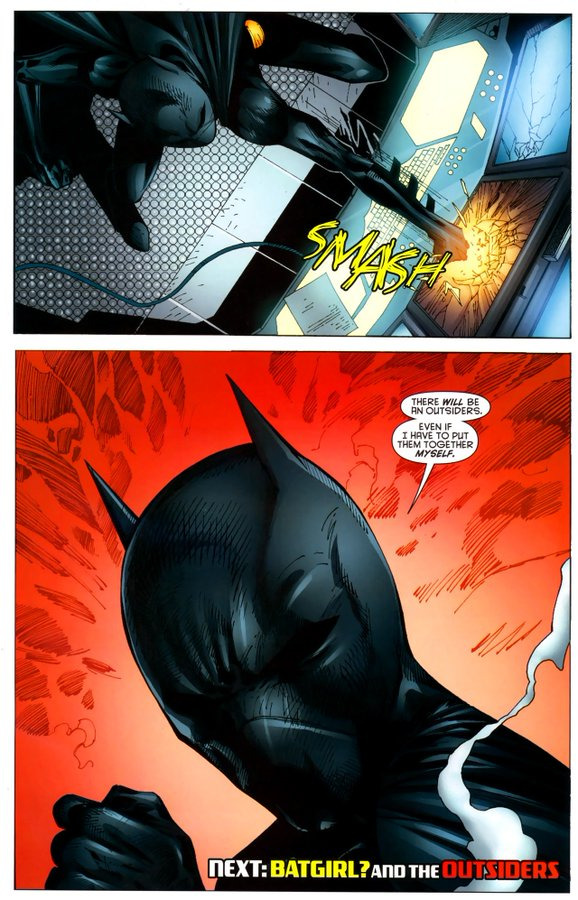
Or maybe NOT with #13's opening title blurb.
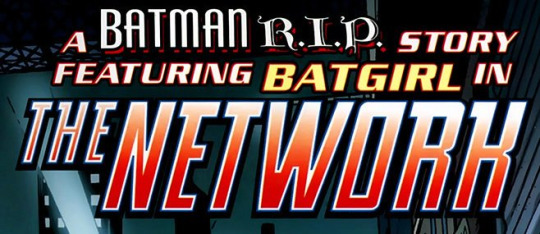
So Cass begins assembling a new team the precursor to Batman Inc-- the Network. She pays Man-Bat a visit and intervenes between Vigilante/Spoiler fighting.

Side note here. This is the first meeting of Cass/Steph after the later returned to the land of the living. So for fans of wanting a more meaningful reunion between the two. Yeah.... Tieri bombed hard here. Wasting panels on Vigilante than Cass/Steph? BOOOOO! BOOO!!!!
So remember that loose plot end of Batgirl Vol. 2? You know the one. Nightwing being an asshole to Cass? Well, it’s back to be concluded here:

As Cass was scheming and creating the Network, Dick Grayson apparently is living up to his first name (this is so damn OOC for Dick).
#14 is the “final issue” of the series as it opens with Cass vs Dick fighting in an alley and the Batmobile speeding toward them both.

We get another flashback of Cass's only encounter with the Riddler (again BOO!!) with her attempting to recruit him (Eddie was trying to be good during this time period but you know status quo gotta be status quo). Until well Dick gonna dick.

Cue the flashforward where we find out who is driving the batmobile: Alfred. And Alfred lays the parental smackdown on both. It is said one can still be frozen at the parental gaze and tone of Alfred in this page to this very day.

This issue is also the only other time Cass's adoption is ever mentioned beyond Batgirl Vol. 2 as well (UNTIL 2020 with DCeased: Unkillables, Batman: Urban Legends, and of course BATMAN: WAYNE FAMILY ADVENTURES). So you have to give kudos for Tieri at least continuing on that thread beat as well. So Dick/Cass mend and the Network is forged for Battle for the Cowl.


Right after this even, B&O was rebranded into just Outsiders with Pete Tomasi at the writing duties. Alfred (team leader), Tatsu, Grace, Rex, and Brion returning with Owl Man, Black Lightning, Halo, and the Creeper, But you might say SOMEONE is missing.
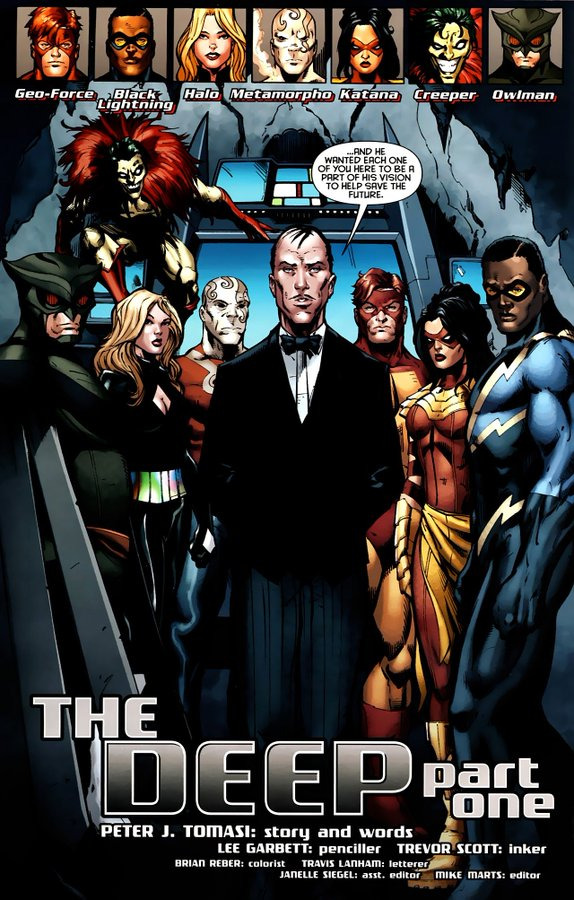
Yes, Tomasi decided to decide Alfred is the one to bring the Outsiders together and drop Cass to the wayside without any explanation. Disregarding all of the prior writers' plots to boot. Normal you might say, but Tomasi with Cass. It just seems to be a nasty vindictive habit he had (so much I think that’s why Tieri and Adam Beechen was making Nightwing such a dick to Cass because Tomasi was writing that comic at the time).
But irony can be amusing.
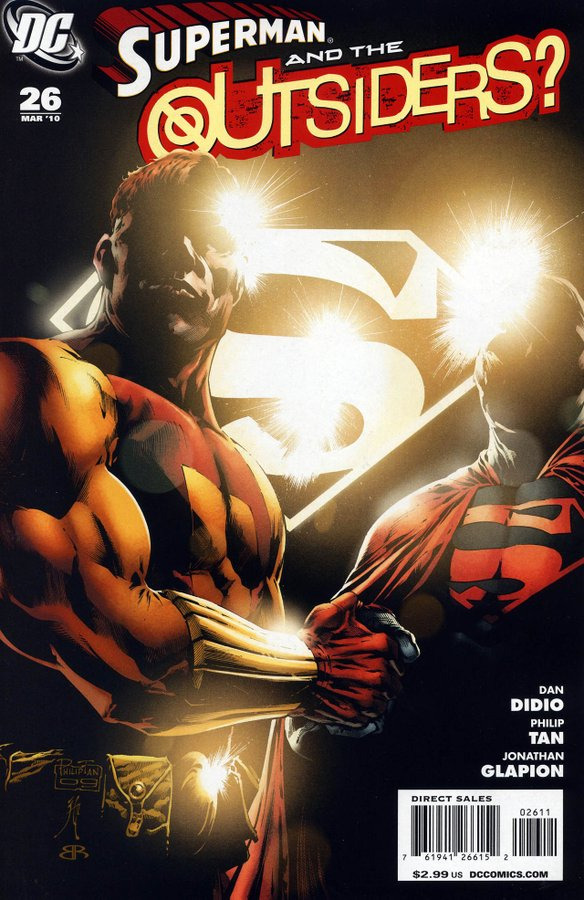
Just ten issues later, #26 Tomasi leaves and Dan DiDio himself comes on board disregarding all of Tomasi's plots save a Tatsu/Owl Man relationship, dropping Alfred, and Eradicator rejoins. Now your thinking okay, Didio is here. No Cass right?
WHELP...
In the final issue #40, we get this splash page. Three appearances of Cass in one page of the Dixon era on the comic (along with homages to various eras of Outsiders). That chill you're feeling might be hell freezing over. DiDio giving Cass some due?
Shocking ain't it?

Though there is some even equal irony as Grant Morrison would ignore all of Didio's stuff in Batman Inc. Which brings us full circle to when Cass would next join the team next in 2019.

But that’s a story for another time...
4 notes
·
View notes
Text
Entry 1: Humanity's Influence
[Disclaimer!!! This post was written in September 3, prior to Splatoon 3's release! These are the author's theories regarding the topic]
Written by: Yayi Fuji
_____________________________________
The world of Splatoon is filled with charm and intuition, easily dragging you into wishing to learn more about it. Since the very first game, we are made aware that humanity is extinct, alongside all mammals on the planet; with the exception of Judd. Their demise was brought upon by 5 World Wars, which ended up violently disturbing the water levels, and wiping off a considerable amount of life. Only ruins and bones are left behind, an entire civilization voided through inconsiderate destruction. After thousands of years however, new creatures evolved to live and survive upon the surface, inklings and octolings becoming the contemporary predominant species. Thus began the Mollusc Era, set 10,000 after the mass-extinction, once intelligent life was prospering again.

However, from what we can see within the game, it seems as though humanity continues to live on, through culture, fashion, structures: things we are undeniably familiar with. We play the game with the idea of a new world, yet find so many striking similarities to our own. So we have to ask, why is this?
It’s not too hard to imagine. Growing into the isolated surface, already filled with remains and technology, everything is basically laid out already, albeit a little rusty. Not only does this explain why there is so much influence, but why cephalopods evolved at such a fast pace. After all, they’ve always been intelligent, astute. Shortly after, Judd awoke from his cryogenic capsule, and was likely able to also communicate crude recountings of his young years. All of these attributes went into creating an image of humanity that fascinated this new generation, and in a way, gave means of idolization.

To start off, it’s rather obvious how much of a big element Turf Wars are to the game and cephalopod culture. The first ever Turf War recorded was 2,000 years prior to the present time in M.E., where they sported weaponry reminiscent of guns and explosives with an artstyle akin to egyptians’. Just having discussed the residue left behind, it would be no surprise if the first things the new life encountered were the artifacts utilized for the wars. It’s an ironic occurrence, but by no means purely a coincidence. It took them no time to modify and reinvent, giving it a less lethal twist, while simultaneously resolving their territorial instincts on a smaller scale as sport. Of course, the Great Turf War would come about 1,900 years later, but that’s a tale for another day.
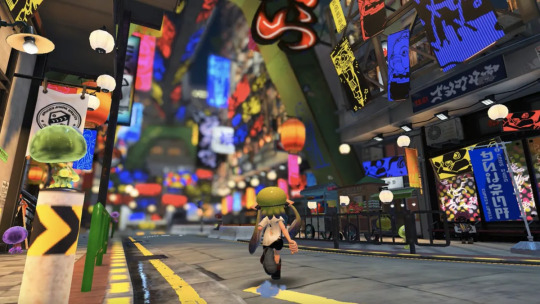
This closely ties in with other major festivities that are undeniably associated with humanity: Splatfests, Splatoweens, and Frosty Fests. These are determined to take place whenever a mysterious fax machine prints out debate topics that were originally documented by humans back when they were alive, sent to outer space via signals, and ultimately returned back to the planet from bouncing over from another. I know, it sounds silly, but it’s true. These messages have become sacred, entire festivals holding place as ritual. Although some Splatfests may be scarcely canon (I.E. collab events), the vast majority are easily understood, most already having new equivalents. This is even including ice cream, milk being one of the main ingredients which is no longer attainable, but still having been replicated somehow. In addition, the holidays of Halloween and Christmas were revamped flawlessly, and continue to be a tradition in their society.
Nonetheless, the list could continue on. There’s just so many other parallels and intricate details within this colorful world, as these are just glimpses of the layers that exist. Humans seem to be such an influential power, and could be credited for many attributes within this world, especially those that do not initially sound rational for non-mammals to have. Now with Splatoon 3 nearly at our fingertips, I am so eager to learn more, especially with mammalians being the main focus of the story mode. Despite all these similarities, the differences shown speak depths, making sure that we still remember that they are not humans, but cephalopods and creatures alike. Although not perfect, they thrive and adapt, with freshness in mind. But hey, I guess they just find us cool too, huh?

3 notes
·
View notes
Text
Understanding the Six-Day War: A Pivotal Moment in Middle Eastern History
In the annals of modern warfare, few conflicts have shaped the geopolitical landscape as profoundly as the Six-Day War of June 1967. Lasting from June 5 to June 10, this brief yet intense confrontation between Israel and its neighboring Arab states marked a watershed moment in the history of the Middle East, reshaping regional dynamics and leaving a lasting impact that reverberates to this day.
Background:
Tensions in the region had been escalating for years prior to the outbreak of the Six-Day War. Hostility between Israel and its Arab neighbors, particularly Egypt and Syria, was fueled by territorial disputes, military build-ups, and political brinkmanship. The immediate trigger for the conflict was the closure of the Straits of Tiran by Egypt, effectively blocking Israel's access to the Red Sea and threatening its maritime trade routes.
The Course of the Conflict:
On June 5, 1967, Israel launched a preemptive strike against Egyptian airfields, decimating the Egyptian Air Force in a matter of hours. This bold and decisive move set the stage for a lightning-fast campaign that saw Israel swiftly gaining control of the Sinai Peninsula, the Gaza Strip, the West Bank (including East Jerusalem), and the Golan Heights, effectively tripling its territory in just six days.
Key Players and Strategies:
Israeli forces, led by figures such as Defense Minister Moshe Dayan and Chief of Staff Yitzhak Rabin, demonstrated remarkable military prowess and coordination during the conflict. Employing a combination of air power, armored divisions, and innovative tactics, they outmaneuvered and overwhelmed their Arab adversaries.
Meanwhile, Egypt, Syria, and Jordan, though possessing larger armies on paper, were caught off guard by the ferocity and efficiency of the Israeli assault. Internal divisions, poor communication, and strategic miscalculations hampered their ability to mount a cohesive defense.
International Response and Aftermath:
The swift Israeli victory sent shockwaves across the globe and triggered a flurry of diplomatic activity. The United Nations Security Council passed Resolution 242, calling for the withdrawal of Israeli forces from occupied territories and emphasizing the principle of land for peace. However, the implementation of this resolution has remained a contentious issue, with negotiations and peace efforts often faltering in the face of deep-rooted animosities and competing territorial claims.
The consequences of the Six-Day War were far-reaching and multifaceted. For Israel, the war was a triumph of survival and security, but it also ushered in a new era of occupation and Palestinian resistance. The Arab world, humiliated by its defeat, grappled with the aftermath, leading to increased radicalization and the rise of movements like the Palestine Liberation Organization (PLO).
Legacy and Lessons Learned:
The Six-Day War left an indelible mark on the collective consciousness of the Middle East, shaping attitudes, policies, and conflicts for decades to come. It underscored the importance of diplomatic efforts, conflict resolution, and the pursuit of peace in a region plagued by volatility and uncertainty.
As we reflect on the events of June 1967, it is essential to heed the lessons of history and strive for a future characterized by cooperation, understanding, and reconciliation. Only through dialogue and mutual respect can the wounds of the past be healed, and the promise of a peaceful Middle East be realized.
Sources:
Book - Britannica - Office of the Historian
#SixDayWar#MiddleEastConflict#ArabIsraeliConflict#1967War#IsraeliHistory#ArabHistory#WarHistory#MilitaryHistory#HistoricalEvents#1960sHistory#History#News#world news
0 notes
Text
Scotland
Being a fan of the series “Outlander” meant I had to travel to the highlands and see for myself everything I ever dreamt about while watching and reading the series while reading the lines of my favourite character James Fraser making my heart flutter.
And no, James Fraser isn’t the only National treasure of Scotland, It’s the Highlands themselves!

Knowing best than letting myself hurrying into going with the flow and buy an airplane ticket; picking up my Eastpak backpack and putting a handful of clothes while forgetting to bring my toothbrush... of course I took a deep breath and told myself “Let’s first get some basic info about the country and plan a little beforehand...”
I looked it up and found a very aesthetic site called www.scotland.org
Where I found a bit of information about “The Highlands”

“By far the largest region in Scotland, the Highlands covers nearly 10,000 sq* miles in northern Scotland. The region is home to stunning scenery, including the legendary Loch Ness.”
“sq” is a unit of area equal to a square one mile long on each side.
POPULATION: 234,000 (APPROX.)
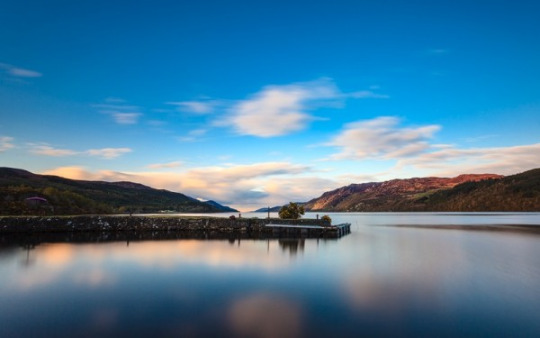
Five fascinating facts!
1. Three languages are spoken in the Highlands: English, Scots and Gaelic
2. The area is divided in two parts: the Great Glen divides the Grampian Mountains to the southeast from the northwest Highlands
3. It has the UK’s highest mountains, ranging from 900-1300m
4. The northwest Highlands are, geologically speaking, 750 million years old
5. Loch Ness holds more fresh water than all the lakes in England and Wales combined
Note: Scottish Gaelic is distinct from Scots, the Middle English-derived language which had come to be spoken in most of the Lowlands of Scotland by the early modern era. Prior to the 15th century, this language was known as Inglis ('English') by its own speakers, with Gaelic being called Scottis ('Scottish').

The Northwest Highlands
No matter how much interesting would be to follow the film scenes and retrace the places of the Outlander film crew, I still wanted to see the things that interested me the most. So I only added one or two places I really wanted to see from Outlander and left the rest to my liking.
I don’t like places with many people, and I prefer slow paced traveling, my interests are mainly the people's culture, nature and traditional gastronomy, I also believe most of the best things in the world are free hence this itinerary:
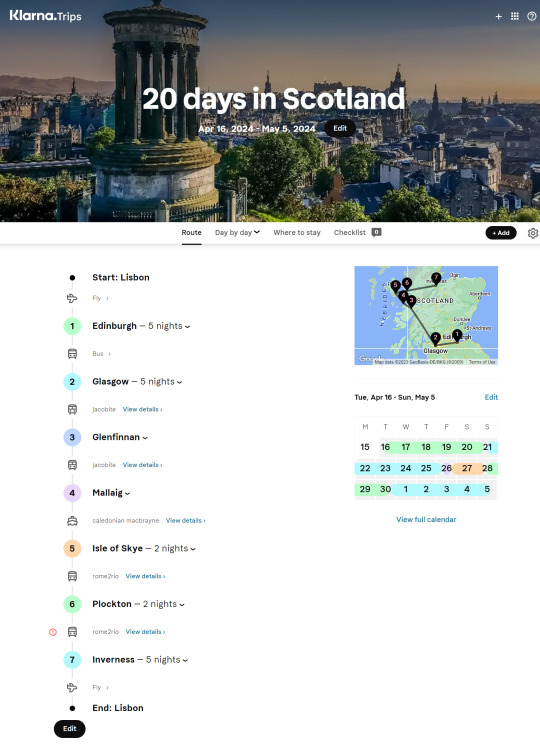
Having only 2,500€ to spend, while the conversion of the coin and the prices made everything so expensive, unfortunately I had to make some sacrifices, like hiring Sam Heughan as my private guide...
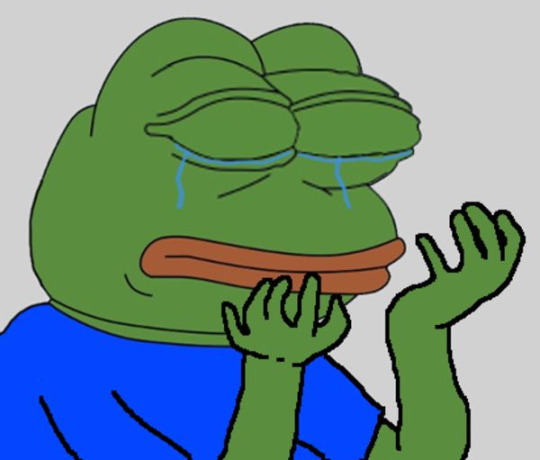
But the budget allowed me at least to leave you with a video of Sam Heughan explaining a few things about Scotland and the amazing language that is Gaelic, one of the main and oldest languages in Scotland, until the brits suppressed the language during the Highland clearances following the Jacobite uprising.
Actually, Outlander is an amazing series that talks about a lot of historical events from Scotland and talks about the Jacobite uprising happened and other important events. The soundtrack and culture is also stunning and I recommend watching it!
The opening of the series is specifically interesting as it maintains the same song that changes the instruments accordingly to the country they are in.
In the first season they made an excellent job in making it sound very Scottish.
youtube
And in the series they speak a little of Gaelic sometimes, for example, the famous word <i> “sassenach” </i> from the series:
youtube
Fortunately! For those of you who might want to learn this amazing language Duolingo has a FREE course on it!

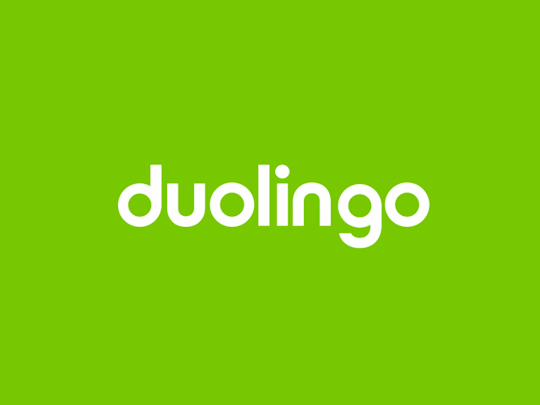
1 note
·
View note
Text
These lads don’t have much music out, but what they have out is a beast. I heard “Holding out my thumb” for the first time and had to listen again. It is addictive as hell. Here is my interview with the talented lads of Burnt Orange.
1- Can you tell us a little history about Burnt Orange? Members etc.?
We formed Burnt Orange in late 2021 (just another COVID baby) and while a relatively new band, Nigel (drums), Marcus (bass) and Adam (vocals) have a much longer connection through our hometown on the West Coast of SA where we all played in a variety of bands growing up. We connected with Tom (Guitar) over the past 2 years who has spent a lot of time in the Adelaide music scene including playing with ‘The Wanderers’ and ‘Hindley Street Country Club’. From the first jam we discovered a great vibe as a group and creating music has flowed naturally.
2- What is your impression of the Adelaide Music Scene?
It feels like the start of a new era really. COVID and the ensuing restrictions had such devastating impacts on the entertainment industry which sadly meant the end for some bands and venues. But since then, there seems to be more focus on local talent from Adelaide venues and events now that people and bands have come out of hibernation. We recently checked out the battle of the bands that was held at ‘The District’ and really enjoyed the quality and diverse range of music that was showcased. It also highlights that there’s an enormous amount of competition out there for gigs, but that can only be a good thing for the industry to reach better standards, right??? It is certainly great to see venues like ‘The District’ giving opportunities to local original acts and we hope to more of these opportunities created by venues as that is such a tangible and real investment into the future of the Adelaide music scene.
3- Do you have a favourite venue to play?
Due to being a new band we have only had the one show at ‘The District’ so far and that is a great stage! But prior to this band, Nigel, Tom and Marcus have all played in ‘The Gov’s’ main room and that was MAGIC! On that note, we’d definitely like to make a shout out to those industry main stays like ‘the Gov’ who have never waivered from their support of live original music, even through all of the ups and downs. We always take the opportunity to return thanks and attend gigs at those sorts of venues where we can. Such great history and atmosphere at those old Rock ‘n’ Roll Pubs and they’re great for both performers and punters alike.
4- Holding out my thumb is the song I heard on Facebook? As a bass player myself I love the bassline. How did that song come together?
That song was born from a riff that our guitarist Tom had up his sleeve. Marcus (who likes to be complicated) then tweaked it to be the “beast” that it is today. But most, if not all, of our songs are collaboratively written and shaped over time and that makes it such a fun process to be apart of! Lyrically the song is about letting someone go to allow them to be happy, while also finding the courage to let go and walk your own path.
5- When can we expect to hear new music from you?
We recorded a live demo of 5 songs at ‘Wundenberg’s Recording Studio’s’ a little while ago that we will use for promotion. We plan to release these very soon on our socials for people to hear! But we also have a bunch of other songs we are working on and can’t wait to play at our next gig. We want to get back into the studio to lay them all down and in the not too distant future we can hopefully release our first full studio album.
6- What is your Career highlight so far?
As a new band on the scene, it would have to be spending time recording our songs and of course playing our first gig together! All of us have had some really great individual highlights along our own musical journey’s but we’ve all really enjoyed coming together to create what we have today, and we think we’ve got something pretty special going on. We can’t wait to showcase our Burnt Orange blend of styles with more audiences soon and create a few more highlights ASAP.
7- If you could invite 3 musicians dead or alive who would you choose?
Well that really does depend on what we’re inviting them to!?!? Plenty of our idol’s that we’d love to party with might not be a hit at Christmas dinner with Gran... Even if we assume it’s somewhere in between it’s very hard to choose. But if we throw some names out there, Chris Cornell, Jeff Buckley and Dave Grohl come to mind, but that list could go on forever! There are so many great people out there who we would love to just have a conversation with!
8- If you were stuck on a deserted island with only 1 album, what would you pick?
Man, that is such a hard question… but after some deliberation we couldn’t really go past Fresh Hits of ‘98… I mean, Celine Dion & Busta Rhymes on the same album???That SHIT just doesn’t happen any more! 🤣
9- What are your long- and short-term goals?
To be honest, we just love jamming, writing, playing and recording music (& drinking beer) together, not to mention sharing our music with as many people as will listen. Our plan is to do as much of all that as we can, wherever we can, for as long as we can and probably feel like the rest will fall into place as the universe (or beer gods) see fit. However we’ve certainly got a few things we’d love to do if we can... Things like, getting back to the west coast to play our tunes to mates and family; venturing interstate would be a lot of fun (ROAD TRIP!!!) and it would be great to get onto the Gov’s main stage again or into the Hindley Street Music Hall amongst many other great venues we’ve got our eyes on.
10- Finally, where can people find out more about you?
https://instagram.com/burnt_orange_band?igshid=YmMyMTA2M2Y=
We also hope to have our music up on SoundCloud and Spotify in the very near future! But anything you need to know will be on Instagram and Facebook for now!
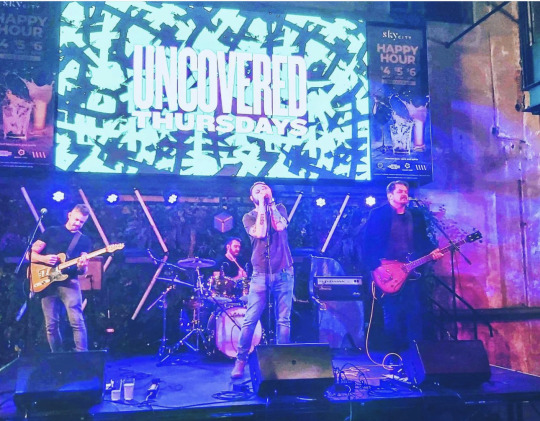


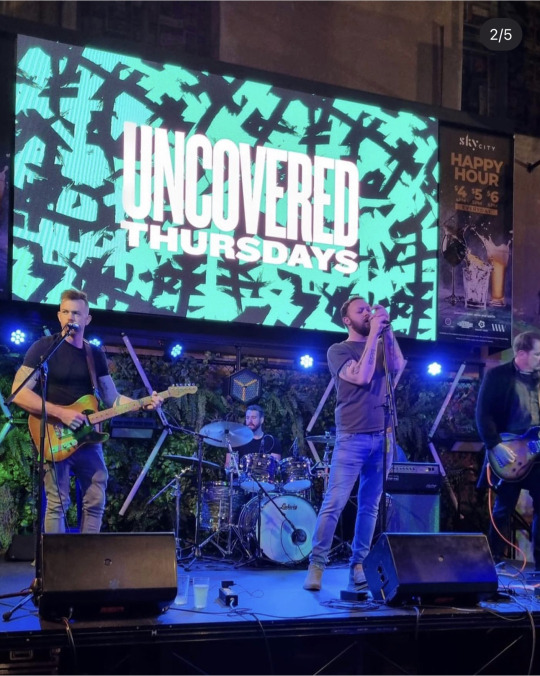






0 notes
Text
🥀❣️
#oc: chiara de laurentis#insp: cosimo de laurentis#x: under the betrayer moon#x: my baby shot me down#v: marvel#temporary tag until i find a cuter one ✨😌#cosimo being killed by a brainwashed chiara for the purpose of framing her for murdering him was all nonna de laurentis’s thing#nonna never even KNEW marc existed as chiara made it VERY much her goal to keep him away from her family and her in laws#they were partners and she made sure to keep her archaeologist work aware from her family life!#so marc was left out of her mentions when she was asked about work! protect him and things ✨😌#like this is of course the era 5 years prior to the events of the show#before she was dusted for 5 years and before she met Steven ✨🥺#and when she decided on separating from cosimo it was for a few reasons!#most of all being that she wanted cosimo to be happy as well! because they both deserved that!#to not be tied to a loveless marriage like both of their parents! sneaking parters into their homes at night etc!#and the third! nonna de laurentis is a snake! she had this planned out since day one! that something would happen to one of them!#*the second#and nonna de laurentis would take the borgia fortune / connections / etc for herself! she knew that!#like i also want to write a convo where like….. okay maybe jake has known about her thing for marc for a looong time now#and considered offering to take nonna de laurentis out but ultimately didn’t out of respect for chiara being his friend ✨🥺#like jake was WELL aware chiara could handle herself :) but now? chiara may just accept his offer skxjjxjx#take him out honey! it’s payback time for what you did ✨🥴✨😤#leg.txt
0 notes
Photo

it’s been five decades since the whole of westeros descended upon king’s landing for a celebration of the peace treaty , and in true fashion the city has gone all out. almost as if they are celebrating more than a bunch of noblity coming to town... and it’s because they are.
every 50 years the known world is graced with the beautiful sight of the draconidis meteor shower. this historic shower was first seen weeks before the peace treaty was signed , the old tale claims it foretold a new era for westeros. the festival of draconidis is a grand affair , a celestial carnival with games , elaborate performers from around the world , contests + tournaments , and of course wine + ale galore. the city of king’s landing truly embraces the festival as many travel from all over the known world because king’s landing has always been the perfect place to view the meteor shower.
the festival lasts for five days , ending on the sixth with a large ball held outside during the meteor shower. there is nothing small about this celebration , each year better than the last.
alrighty so ! when we open on friday at 3 p.m. cst you are free to dive in and write any part of arriving in king’s landing ( you can write things for prior to the festival start if you like ) or any point of the festival in your threads. the festival will last ooc for two weeks , between july 22 ( 3 p.m. cst ) - aug 5 ( noon cst ). ic it lasts 5 days , the sixth being the ball.
the ball is not to be written yet , as that will be the pt. 2 to this little bit which will begin on aug 5 at noon cst.
a side note , unless otherwise stated you will always. be able to continue your threads from one event / time to the next. all festival threads can continue past aug 5 , but no new starters in regards to the festival can be posted.
everyone gets ONE free starter when we open , please utilize this to facilitate being inclusive + making people feel welcome. closed starters are always allowed , i just ask you try to either write one open or reply to a few ! ( or both for gold stars ) please tag all OPEN STARTERS with the following tags: rfms.event , rfms.start + rfms.event01. the last two tags are for opens only ! please do not use the open starter tag for closed starters.
if you have any questions please ask ! this description was left kinda vague so people can take this festival + truly give your own little spin on things. we want you to have fun + be creative , not limited by what we say is there + isn’t !
quite possibly the most important note of this post ! when we open tomorrow , you must post at least once per character ic within 48 hours or they will be reopened ! if you are unable to do so PLEASE message us so we do not reopen your characters !!! this is purely to reopen roles that people may have joined but are no longer interested , not to remove people who might just be busy !
7 notes
·
View notes
Text
BBC Ghosts OC Questions: Shannon Rose
you can find all the questions without my answers here from the lovely @jamiewintons
(if I ever write a fic about her and Thomas, it'll absolutely be called "Every Rose Has Its Thorne" because I'm a disgustingly cheesy bitch)
So before I get started, the Shannon timeline is a bit interesting. For the majority of these answers, she is alive and well! She doesn't die until after she's lived at Button House for over 2 years. LET'S GET INTO IT!
1. What era does your character originate from?: Modern day! She started renting a room at Button House during the pandemic. Button House couldn’t get any event bookings and Shannon’s band couldn’t land any gigs. Mike and Alison needed money and Shannon couldn’t afford rent at her old apartment. Once the pandemic lets up a bit, Shannon's band ends up becoming the Button House band. It all worked out quite well!
2. How old was your character at their time of death?: late 20’s, maybe early 30's (I haven’t decided on an exact age yet)
3. How did your character die? Is there any visual indication of their cause of death?:
Okay this is kinda complicated so I'll start with how she is able to see the ghosts. Shannon had a unique near death experience a few years prior to coming to Button House. She was attacked by a fan turned stalker in an alleyway. He shot her and then quickly fled the scene. Luckily, a ghost nurse with similar abilities to Julian was nearby and was able to slow the bleeding enough before an ambulance came. Without her, Shannon would have died. As she was slowly bleeding out, Shannon was flickering between dead and alive, between being able to see the nurse helping her and her disappearing. She needed something to anchor her in the moment so she grasped at the nurse's wrist, holding it steady. Even when she was fully alive and couldn't see the nurse, she managed to maintain her hold on to that invisible, ghostly wrist. Post that near death experience, she could then see and touch ghosts! She can turn it on and off instinctually though, like how the ghosts can either walk through a chair or choose to sit on it. She can choose to pass through them or physically interact with them.
For her actual death, she was diagnosed with inoperable ovarian cancer. Rather than endure fruitless treatments, Shannon decided to face death head on and opted for medically assisted suicide at Button House. Her doctor, sister, Alison, and Thomas were present when she ingested the dosage. Her sister and Thomas were each holding one of her hands as she passed on.
4. Which of their fellow ghosts is your character closest to?: Kitty, Pat, Humphrey, and Thomas
5. Are there any ghosts that your character doesn’t get along with? If so, who, and why do they not get along?: She and Julian don’t have too much to talk about. I think part of it is jealousy of Shannon's ability. He's kind of limited to just his finger while her gift affects her whole body. Also he’s a bit of a peeping Tom but that's a whole other story.
6. What is your character’s relationship with Alison like?: Once Shannon moved in and accidentally revealed that she could see the ghosts, she and Alison quickly bonded over their shared gifts (Mike was a bit annoyed that someone else could see the ghosts and he still couldn’t). They’re good friends and share a lot of the management of the ghosts needs. Since Shannon can actually physically interact with the ghosts, they come to her a bit more often. Kitty has Shannon pass on a lot of hugs for Alison!
7. Does your character have a romantic interest in anyone? If so, who? Is there any chance that a relationship will blossom between them?: Thomas, of course! Before Shannon arrived, Thomas had fully given up on someone returning his affections. He’d stopped fawning over Alison and falling for anyone who walked through the door. As Alison was interviewing potential renters, she was honestly surprised that Thomas wasn’t drooling over every candidate. But then in came Shan. He learned from Alison that his previous forms of courting were overbearing so he really had to slow things down, build a friendship first and be happy if that's all that resulted from it. It took a while but they eventually got together once she initiated under the mistletoe one Christmas!
The news of Shannon’s diagnosis was bittersweet for Thomas. He wanted so much more for her than the cards she was dealt but he’s ultimately glad that he’ll never have to lose her now! With their unique circumstances, they spent a lot of time talking about the eventual expiration date of their relationship. The diagnosis, while again not what anyone wanted, was in some ways a relief. That sounds kinda messed up but I promise it makes sense in the bigger picture.
8. If it was your character’s turn to pick for Film Club, what film would they choose and why?: My Best Friend’s Wedding! It’s got everything: romance, comedy, a few singing sequences, and an ending that makes her cry every time!
9. What kind of television shows does your character enjoy? Would any of the other ghosts want to watch with them?: She loves long, cinematic tv shows that she can binge with Pat! Stuff like Lost or GoT! Something where they can theorize and delve into the lore.
10. Does your character try to interact with Mike, despite knowing that he cannot see or hear them?: She and Mike were good friends when she was alive! Once she’s died, she still tries to interact with him through nudges, writing notes, or typing on the laptop. Julian tries to impersonate her in those moments though so she has to keep an eye on him.
11. What kind of books would Alison buy for your character?: Shannon loves audiobooks! She and Fanny love listening to murder mysteries! They are currently reading the Thursday Murder Club series and anxiously awaiting the next release!
12. Does your character have a special power? If yes, is there any meaning to why your character has this particular power? (for example, is it related to how they died, or indicative of their personality?): Her ability to interact with the ghosts in life has flipped so she can still physically interact with the land of the living in death. It’s very natural and instinctual; it doesn’t take effort and concentration like it does for Julian (again fueling the jealousy. I hope they bury the hatchet at some point!)
13. How do they act on their death day? Do they become withdrawn, upset, or does it simply not bother them anymore?: She doesn’t really mind it that much! Shan was really at peace with her decision to end her life. She and Thomas view it has a bit of an anniversary (almost an engagement) for their relationship so if anything it’s a happy occasion!
14. How did they react to realising that they were dead and had become a ghost?: Since she planned her death meticulously, she knew what to expect. She interviewed all the ghosts before about what the experience of dying was like. Once she had passed on, she took everything in slowly, taking note of every change. It was almost scientific.
15. What was your character’s relationship with their family/friends like when they were alive?: Her parents had passed on before her (father to early-onset dementia, mother to covid). She had a great relationship with both of them but their deaths were long, drawn out, and filled with suffering. When faced with that herself, she knew she wanted different. But that meant leaving behind her older sister, Meredith. They had never been very close. Meredith was always the good kid, now a perfect wife and mother while Shannon was a bit of a loose cannon. They made peace in the end though.
All of her (living) friends are in her band, her best friend being the rhythm guitarist, Ross. They've been best friends for years and started the band together in early high school. The rest of the band members have changed over the years, but Shan and Ross stay the same.
16. If your character saw Humphrey’s head left stranded on the floor, what would they do?: Scoop him up and go bird watching! It’s their favorite thing to do together!
17. What kind of music would your character enjoy? Would they be willing to get up and perform for Music Club?: Being a musician, Shannon has a very eclectic taste in music. All of her friendships with the ghosts started with bonding over a shared music taste. 70’s music is all Pat, boy bands are Kitty’s fav, Fanny loves Barbra Streisand! Thomas really struggled finding a musical foothold with Shannon so they spent a lot of time trying to find something in common. In the end, they decided to write something together. She handled the music and he wrote the lyrics. They’d probably perform one of their originals for music club!
18. What kind of activities does your character wish they could participate in, but cannot due to being dead? (Especially things that weren’t around when they were still alive): She really misses performing with her band! They ended up becoming the house band for Button House once the pandemic started letting up and still play for a lot of their events. Shan still gets to see them but so wishes she could be up on the stage with them! She misses her buddies, Ross in particular.
19. What would your character wear if they could today?: Honestly, I haven’t figured out what she’s wearing in death yet. When she settles on assisted suicide, she becomes obsessed with the aesthetic of death. Should she wear a skirt, jeans? Hair up or down? Makeup? Contacts or glasses? Would sleeping with earring backs poking you in the head be annoying for the rest of time or do you get used to it at some point? Even dumb things like her pubic hair! Does she need to book a wax before she dies? I mean this is the rest of eternity we’re talking about! It all becomes really overwhelming! And Thomas isn't helpful at all with the decision making!!
20. Did your character witness the deaths of any of the ghosts that died after them?: Nope!
21. How does your character feel about the plague ghosts?: She was a bit overwhelmed when she first met them. There’s just so many in such a small space. But she loves how comfortable and respectful they are with each other! They are so content despite their circumstances! She doesn’t spend too much time with them but she likes them!
(Choose your own question! Ask me anything about my character!)
#wowzers that was a lot#but this is my favorite thing to think about so it's got ass loads of details#this was fairly restrained if you can believe it#shannon rose#thomas x shannon
3 notes
·
View notes
Note
hi, any advice on timeline and era etc stuff? I have dyscalculia so numbers and measurements are meaningless to me and it’s really difficult to figure out how much time should lapse (on a large scale; time periods, millennia, eras, etc, not stuff like in one persons lifespan) between eras and events, especially in regards to political n social n technological etc changes
Feral: That depends. There isn’t one answer. You’re asking for longer time periods than a generation or a lifetime, but for scale, take what’s happening now. How many calamities, major political events, social trends, and changes in technology (and how we interact with it) have happened in the year 2020? Since the year 2016? Since 2008? Since 2001? How are they grouped together or spaced apart? And these are all working on each other. In the USA where I live, the 9/11 attacks absolutely have a direct causal effect with the politics that led to the 2016 election (actually before that a Supreme Court decision in the 2000 election also had an impact on that result), and the results of the 2016 election impacted how COVID has been handled this year. That’s 20 years, so when we’re looking at longer timeframes, we scale up. We see gaps and groupings and there just isn’t a specific “oh every decade/score/century, these types of events happen.”
To quote a particularly relevant introduction on Wikipedia:
This results in descriptive abstractions that provide convenient terms for periods of time with relatively stable characteristics. However, determining the precise beginning and ending to any ‘period’ is often arbitrary, since it has changed over time over the course of history.
To the extent that history is continuous and not generalized, all systems of periodization are more or less arbitrary. Yet without named periods, however clumsy or imprecise, past time would be nothing more than scattered events without a framework to help us understand them.
Eras, of the non-geological or -cosmological sort, or time periods are culturally determined, completely variable in length, and often overlap. For example, the beginning of the Victorian Era, 64 years, (defined by Victoria’s rule of England) of the Anglo-influenced world overlapped with the Antebellum Era, 78 years, (defined by political and social tensions in the lead up to the American Civil War) of the United States, which is also part of the Anglo-influenced world, and then following the end of the Antebellum Era, was the American Civil War, 4 years, and then the Reconstruction Era, 14 years (the first 2 of which are within the Civil War), which are both fully contained within the Victorian Era. Typically, when you are trying to think about eras, think about political rulership, wars, and large scale trends like artistic styles. It may also be helpful to familiarize yourself with the Three-Age System, which can be applied individually on cultures, rather describing trends for the whole world.
What it really comes down to when we think of eras and time periods is almost like a type of pareidolia. People see groupings of like things happening and put this grouping into a bubble of time, which kinda doesn’t actually exist in objective reality and is more or less a group hallucination on a massive scale. It calls to mind what Zeno’s arrow might have actually been trying to describe - not to say that this paradox is infallible, but it’s an interesting thought exercise, especially once you get into the quantum Zeno effect.
Now that I have fully diverged from the question at hand, we’ll get back to it. Let’s look at one technology type and how much time elapses between developments as well as some tie-in technological, social, and political forces that may be acting on the developments or that the developments might be acting on. I’ll also note how this technology traverses the eras of history as I find that looking at one discrete set over time is easier than just trying to look at the big picture. Let’s look at the history of printing.
(With hopes that it will be easier for you to conceptualize, I will use simplified (aka rounded up/down) timeframes written numerically rather than spelled out or via terms like decade or century so at the very least you can compare length of numbers. I’m also going to link as many Wikipedia articles as I can - I like Wikipedia for this because of its incredible cross-indexing and how it strings relevant articles together into a series, often chronologically. If the numbers are still challenging for you, I will summarize without at the end.)
5,520 years ago, the very first form of printing we know about is done with cylinders rolled over wet clay in Sumer in 3500 BCE, the beginning of the Early Bronze Age.
3,700 years later, woodblock printing is developed in China somewhere around 200 CE/AD, just after the end of the Pax Romana in Europe.
700 years later, the next development of printing is movable type, which is developed in China in 1040. 26 years later, on the other side of the world, in 1066 is the Battle of Hastings and the establishment of the Norman Era of rulership in England, in another 20 years, in 1086, the Domesday Book is hand written in 2 volumes: 1 is 764 8”x15” pages, the other 900 8”x11” pages.
400 years later gives us the Gutenburg printing press that is developed in Germany (at the time in the Holy Roman Empire) in 1440. This is during the Renaissance Era; it’s also the Era of Humanism, and often called the Early Modern Period. Martin Luther will write the 95 Theses less than 80 years later and start the Protestant Reformation, largely thanks to the ability for the theses to be easily copied by the printing press and spread quickly.
75 years later we have etching in 1515. 90 years later, the first weekly “true” newspaper, the Relation, begins printing in 1604.
130 years later we have mezzotint in 1642, which is the start of the First English Civil War, which will last for 4 years. Depending on your preference, the Age of Enlightenment either began 5 years before or 40 years later (unless you’re French).
130 years later we have aquatint in 1772. That is right at the beginning of the American Revolution: 2 years after the Boston Massacre; 1 year before the Boston Tea Party; 2 years before the Intolerable Acts and the First Continental Congress; 3 years before Patrick Henry’s “Give Me Liberty or Give Me Death” Speech (which is printed and shared across the colonies), Paul Revere’s Ride, and the Battle of Lexington & Concord; and finally 4 years before Thomas Paine’s Common Sense is published, the signing of the Declaration of Independence (which is printed and shared across the colonies), Nathan Hale’s execution for treason against the Crown, and Washington’s Crossing of the Delaware.
25 years later lithography is developed in 1796; the year prior Napoleon overthrows le Directoire.
40 years later we have chromolithography in 1837, the year Victoria ascends and the first electric/battery powered locomotive is invented.
5 years later is the rotary press in 1843. The First Industrial Revolution is over.
15 years later is the hectograph in 1860. 1 year later, the American Civil War begins.
15 years later is offset printing in 1875. 1 year before, the first commercial typewriter becomes available. 1 year later is Bell and Watson’s first phone call in 1876.
10 years later is hotmetal typing in 1884.
1 year later is the mimeograph in 1885. 2 years later is Black Monday. 5-10 years later the radio is invented.
20 years later is the photostat and rectigraph in 1907.
4 years later is screen printing in 1911. 3 years later WWI begins in 1914.
10 years later is the spirit duplicator in 1923. The Roaring Twenties.
2 years later is dot matrix printing in 1925. 4 years later is the Great Crash.
10 years later is xerography in 1938, the same year as the first digital computer. 1 year later WWII begins in 1939.
2 years later is spark printing in 1940. 1 year later is the Attack on Pearl Harbor.
9 years later is phototypesetting in 1949. The USSR detonates their first atomic bomb.
1 year later is inkjet printing in 1950. Truman orders the development of the hydrogen bomb. Apartheid becomes law in South Africa.
7 years later is dye-sublimation in 1957. 6 years later, Martin Luther King, Jr. gives his “I Have a Dream” Speech.
12 years later is laser printing in 1969, the summer of which is known for very Very.
3 years later is thermal printing in 1972. The break-in at the Watergate Office Building is this same year and 2 years later Nixon resigns.
14 years later is 3D printing in 1986, the year Pixar Animation is founded and the year after the beginning of the Iran-Contra Affair.
1 year later is solid ink printing in 1987. 2 years later is the invention of the World Wide Web, and the internet as we know it.
4 years later is digital printing in 1991, the same year the USSR dissolved. 2 years before, the Berlin Wall fell.
There have been no significant developments in the history of printing since 1991.
So, let’s look at some averages to help us consume this data. Printing has a history of 5,520 years. It took 3,700 years for another development to occur, and then another 700 years after that - in other words, in the first 4,400 years of printing, there were 3 developments, equalling to an average of 1 every 1,470 years. In the 400 years between 1440 and 1843, there were 7 developments (average of 1 every 57 years). In the next 100 years between 1860 and 1957, there were 14 developments (average of 1 every 7 years but with 1 year having 2 developments simultaneously). In the next 22 years between 1969 and 1991, there were 5 developments (average of 1 every 4 years).
While the general trend is that the more a technology develops, the faster it develops, a trend is not the whole picture. Consider: in the 90 years of 1796-1885, there were 6 developments, making the average 1 every 15 years. In the 85 years of 1907-1991, there were 15 developments, making the average 1 every 6 years. There has not been a development in the past 30 years! There hasn’t been this large of a gap since 1837, 180 years ago.
In general, without numbers, what I think we can see here is that sometimes a certain development, like the printing press, can usher in a new era, and sometimes reactions to what else is happening in the world can pressure someone into developing something new, but often times, most times, when you look at just one thing under microscope over time, why that thing is produced in this era but not that era has nothing to do with the eras in question. When we create time periods, we’re generally doing it after the fact. No one living under the rule of the Roman Empire in 100 CE was thinking to themselves, “ah yes, the Pax Romana, when we have peace for 200 years!”
So applying all of this to worldbuilding, I see two methods that you can use together, to create a timeline that makes sense and is useful to your storytelling.
Method the first, arbitrarily create time bubbles of various lengths - I recommend the use of index cards for this. Index card A is 7 years; card B is 150 years; card C is 47 years and so on. Then take big ideas and put those onto your cards; use inspiration from real history. “I want the War of the Roses but condensed into 7 years.” “A Mongolian Empire type expansion happens over 150 years.” “There’s a 47 year Renaissance of fascination with Ancient History.” Then take those cards, lay them out into roughly the order in which you want them to occur, maybe overlap them a little, especially if they are happening in different parts of your world. Remember that time is not actually linear and things do not happen in a linear, narrative manner in the real world, so there can be wild leaps; there can be regressions; and you don’t have to follow real world history here - though you may want to the first time as a helpful exercise. It’s also very unlikely that you will ever have to know exactly how many years are between the eras or what the interstitial eras are.
Method the second, list all the major historical events, inventions, etc that you want/need to have happened. Start with what directly impacts your main characters and plot. “MC’s great-grandfather is humiliatingly defeated in battle, casting a pall of embarrassment across the generations following and ultimately putting the MC in the position that she starts in.” “The first great wizard codifies the 10 Laws of the Important Magical Order that the MC is trying to earn her place in.” Put these in an order that makes sense to you, keeping in mind that it’s not going to be a perfect progression. Again, you don’t need to know how many years there are between each event, but if great-grandpa was the last in a very long line of family members allowed to be in the Important Magical Order, then that IMO had to be founded first, and there would probably be some events between these two.
Then, when you have your two timelines, one of era/time periods and one of events, graft them together. You may have to shift some things to make it work, but consider the “feeling” or theme of the eras and what events make sense in relation to those feelings. Additionally would this event be more suited to happening when the era is new and is finding itself or when the era is solidly on course or is it an event that would completely shatter the illusion of the era and usher in a new one? Does it make sense for your great wizard to be codifying her laws in the expansion of an empire, or during a period of relative peace and prosperity in an established empire, or before empires were a thing in this world and few traveled far from home?
Tex: I’ve found that historically important events are caused for roughly two reasons - one, an invention that others capitalize on for an exponential growth into other inventions/social uses, and two, someone got sick of someone else’s crap and did something about it. Natural disasters will happen with enough frequency to be noted (see: the Little Ice Age, the Black Death, and the 1883 eruption of Krakatoa), although there’s little prediction for them because of the lack of observable build up in activity.
To pull from Feral’s timeline of examples, writing is popularly attributed to being invented in Sumer, 5,520 years ago - it’s our oldest found example, at any rate, though I’ve learned to never say never on archaeological discoveries.
What prompted this invention? Things rarely occur out of the blue, and rarely without interaction from other domains - where could writing have come from? Maybe art? What about from the creation of a tool, a reuse of certain skill sets? Something else we haven’t thought of yet?
So that’s one half of the question. But what about the other half - what did people around the inventor (multiple inventors?) think of this new thing? Deliberately associating a particular sound with a particular object - even a 2D object like pressing shapes into a piece of clay - and then standardizing it, is no mean feat. How did this agreement even happen? Were there arguments about how to do these graphemes, how best to shape them? What about which phoneme to each?
I doubt Sumerian cuneiform was created in a day, and likewise I doubt that language popped into existence on a whim. To keep pulling from this example, language composition has a strong effect on how we interact with our environment (University of Missouri-St Louis Libraries), but it conversely is also deeply affected by the environment its users create (Nature).
Because of this, I think it’s easier to work from a different angle - figure out what your major events are, and what eras you’re covering. If these major events also define an era, that’s even better! Working out how long everything each thing takes is ultimately a bunch of minor details, so it’s up to you how much your plot actively needs them, rather than decoration to your story meant to amuse you more than your audience.
58 notes
·
View notes
Note
Hello. I found your acc some weeks ago and read through all your rants posts. I love them so much because you're so realistic and mature ;-;. Can I rant too? Please just ignore this if you hate it🥺�� (Also English isn't my first language so I'm sorry if this doesn't make sense)
Intro: I'm a wm stan. A miracle and a fuse. I've liked bipo since their debut but didn't really stan them because 2nd gen era was such a golden era I followed every groups. But I truly cherishes the 5 of them.
So. I realised now why I am not able to fully support jy. Not as much as I'd like to. It's because, he's a leader that could've protected bipo but he chose not to.
...
I cried so hard when Hyejin left omgeol because she didn't deserve all the hate and negativity. She was basically leaving the group for her own health. Which is good for her🗣️❤️
And then Minseok left. I remembered feeling so empty. It's so weird. No hints. No nothing. He just left. And now he looks happy cooking in his ig.
...
And then I learnt that jy and baro left. I thought. Hey, maybe they just want to do something new. Like Minseok did. And Baro did what I expected him to do. Be an actor. But jy. He left to continue... being an idol???
Idk but it hurts so much because he's just pursuing the same thing but he left bipo. Trust me I love him and really think it's a good thing he left wm. He's ambitious and always feel like he need to grow even further as a performer, I think. He's a great person. But I can't shake the feelings he did it without telling the boys. Like he made up his minds looong before he left.
And the three boys? He just left them. And on bad terms at that.
My point is really, I've been broken hearted twice for two different reasons. One was truly heartbreaking and the other was just not meant to be. I get it.
But jy. He chose to leave because he, probably, thinks that he won't be able to do much with bipo. I hate it. I hate that I have this thinking. I should be happy for him but I can't. Not when I saw how worried cnu was and how damaging it was for chandeul.
Now that that's been said. GOOD GRIEF HE'S GONE. I CAN FINALLY SEE GONGCHAN BLOOMING TO HIS FULL POTENTIAL YASS. AND THE THREE HAVE ALWAYS BEEN THE SOFTEST TOGETHER EVEN WHEN THEY WERE FIVE BEFORE.
Good luck to jy and baro for their future endeavours but really, I couldn't care less abt jy.
That's all.
Have a nice day love❤️🤗
hello~!! thank you so much for taking the time to read my long-winded rants oh my goodness 🙈💕 that must have taken you a long time but I appreciate you reading them~ You are always welcome to come here to rant any time you feel like it!
Good points, the circumstances which JinE and Laun left are completely different. They were doing so for their own health (physical and mental), and have gone on to live much happier, healthier lives outsides of the idol industry. Yoonji too, from what I've seen as well, seems to be much happier after leaving WM. (Also side note, Hyejin was my bias in OMG and I was so so sad as well to see what a toll it took on her health;; just so glad they're all doing better)
Yeah, Baro always has shown an interest in acting. Before he got into WM, he was going to pursue acting in university, and by the time we fast forward to the end of their original 7 year contract, enough events had taken place where it was understandable for Baro to be stepping back from the idol world. And since then, he has stayed true to his acting desires. Jinyoung has seemed to be a bit more all over the place, setting up (presumably) his own company and recording studio, still releasing songs/OSTs, acting, fansigns, etc. So it's much more difficult to say what his goals were when leaving WM/Bipo, other than to guess he just didn't want to be in the group anymore (or at least for the foreseeable future).
And of course, the way they seemed to have left (which I'm sure you read enough about in my prior asks/rants lol) just seem to indicate there was a lot of things left unsaid, leading to bad feelings that A3 have made known.
I'm with you, in that I hope Baro and Jinyoung have continued success and happiness in what they're doing. I also hope in time, 'B1A4' will stop being mentioned to them, because all it does is create tensions for them, A3, and the fandom. And like you said, Shindeulchan have reached a point of happiness without them so, really, good grief is right 😂
#also your english if very good!! i wouldn't have guessed it wasn't your first language!! <3#b1a4#jinyoung#baro#shindeulchan#cnu#sandeul#gongchan#ot5#oh my girl#jine#onf#laun#text#ask#reply#wm entertainment
9 notes
·
View notes
Link
Imagine that the US was competing in a space race with some third world country, say Zambia, for whatever reason. Americans of course would have orders of magnitude more money to throw at the problem, and the most respected aerospace engineers in the world, with degrees from the best universities and publications in the top journals. Zambia would have none of this. What should our reaction be if, after a decade, Zambia had made more progress?
Obviously, it would call into question the entire field of aerospace engineering. What good were all those Google Scholar pages filled with thousands of citations, all the knowledge gained from our labs and universities, if Western science gets outcompeted by the third world?
For all that has been said about Afghanistan, no one has noticed that this is precisely what just happened to political science. The American-led coalition had countless experts with backgrounds pertaining to every part of the mission on their side: people who had done their dissertations on topics like state building, terrorism, military-civilian relations, and gender in the military. General David Petraeus, who helped sell Obama on the troop surge that made everything in Afghanistan worse, earned a PhD from Princeton and was supposedly an expert in “counterinsurgency theory.” Ashraf Ghani, the just deposed president of the country, has a PhD in anthropology from Columbia and is the co-author of a book literally called Fixing Failed States. This was his territory. It’s as if Wernher von Braun had been given all the resources in the world to run a space program and had been beaten to the moon by an African witch doctor.
…
Phil Tetlock’s work on experts is one of those things that gets a lot of attention, but still manages to be underrated. In his 2005 Expert Political Judgment: How Good Is It? How Can We Know?, he found that the forecasting abilities of subject-matter experts were no better than educated laymen when it came to predicting geopolitical events and economic outcomes. As Bryan Caplan points out, we shouldn’t exaggerate the results here and provide too much fodder for populists; the questions asked were chosen for their difficulty, and the experts were being compared to laymen who nonetheless had met some threshold of education and competence.
At the same time, we shouldn’t put too little emphasis on the results either. They show that “expertise” as we understand it is largely fake. Should you listen to epidemiologists or economists when it comes to COVID-19? Conventional wisdom says “trust the experts.” The lesson of Tetlock (and the Afghanistan War), is that while you certainly shouldn’t be getting all your information from your uncle’s Facebook Wall, there is no reason to start with a strong prior that people with medical degrees know more than any intelligent person who honestly looks at the available data.
…
I think one of the most interesting articles of the COVID era was a piece called “Beware of Facts Man” by Annie Lowrey, published in The Atlantic.
…
The reaction to this piece was something along the lines of “ha ha, look at this liberal who hates facts.” But there’s a serious argument under the snark, and it’s that you should trust credentials over Facts Man and his amateurish takes. In recent days, a 2019 paper on “Epistemic Trespassing” has been making the rounds on Twitter. The theory that specialization is important is not on its face absurd, and probably strikes most people as natural. In the hard sciences and other places where social desirability bias and partisanship have less of a role to play, it’s probably a safe assumption. In fact, academia is in many ways premised on the idea, as we have experts in “labor economics,” “state capacity,” “epidemiology,” etc. instead of just having a world where we select the smartest people and tell them to work on the most important questions.
But what Tetlock did was test this hypothesis directly in the social sciences, and he found that subject-matter experts and Facts Man basically tied.
…
Interestingly, one of the best defenses of “Facts Man” during the COVID era was written by Annie Lowrey’s husband, Ezra Klein. His April 2021 piece in The New York Times showed how economist Alex Tabarrok had consistently disagreed with the medical establishment throughout the pandemic, and was always right. You have the “Credentials vs. Facts Man” debate within one elite media couple. If this was a movie they would’ve switched the genders, but since this is real life, stereotypes are confirmed and the husband and wife take the positions you would expect.
…
In the end, I don’t think my dissertation contributed much to human knowledge, making it no different than the vast majority of dissertations that have been written throughout history. The main reason is that most of the time public opinion doesn’t really matter in foreign policy. People generally aren’t paying attention, and the vast majority of decisions are made out of public sight. How many Americans know or care that North Macedonia and Montenegro joined NATO in the last few years? Most of the time, elites do what they want, influenced by their own ideological commitments and powerful lobby groups. In times of crisis, when people do pay attention, they can be manipulated pretty easily by the media or other partisan sources.
If public opinion doesn’t matter in foreign policy, why is there so much study of public opinion and foreign policy? There’s a saying in academia that “instead of measuring what we value, we value what we can measure.” It’s easy to do public opinion polls and survey experiments, as you can derive a hypothesis, get an answer, and make it look sciency in charts and graphs. To show that your results have relevance to the real world, you cite some papers that supposedly find that public opinion matters, maybe including one based on a regression showing that under very specific conditions foreign policy determined the results of an election, and maybe it’s well done and maybe not, but again, as long as you put the words together and the citations in the right format nobody has time to check any of this. The people conducting peer review on your work will be those who have already decided to study the topic, so you couldn’t find a more biased referee if you tried.
Thus, to be an IR scholar, the two main options are you can either use statistical methods that don’t work, or actually find answers to questions, but those questions are so narrow that they have no real world impact or relevance. A smaller portion of academics in the field just produce postmodern-generator style garbage, hence “feminist theories of IR.” You can also build game theoretic models that, like the statistical work in the field, are based on a thousand assumptions that are probably false and no one will ever check. The older tradition of Kennan and Mearsheimer is better and more accessible than what has come lately, but the field is moving away from that and, like a lot of things, towards scientism and identity politics.
…
At some point, I decided that if I wanted to study and understand important questions, and do so in a way that was accessible to others, I’d have a better chance outside of the academy. Sometimes people thinking about an academic career reach out to me, and ask for advice. For people who want to go into the social sciences, I always tell them not to do it. If you have something to say, take it to Substack, or CSPI, or whatever. If it’s actually important and interesting enough to get anyone’s attention, you’ll be able to find funding.
If you think your topic of interest is too esoteric to find an audience, know that my friend Razib Khan, who writes about the Mongol empire, Y-chromosomes and haplotypes and such, makes a living doing this. If you want to be an experimental physicist, this advice probably doesn’t apply, and you need lab mates, major funding sources, etc. If you just want to collect and analyze data in a way that can be done without institutional support, run away from the university system.
The main problem with academia is not just the political bias, although that’s another reason to do something else with your life. It’s the entire concept of specialization, which holds that you need some secret tools or methods to understand what we call “political science” or “sociology,” and that these fields have boundaries between them that should be respected in the first place. Quantitative methods are helpful and can be applied widely, but in learning stats there are steep diminishing returns.
…
Outside of political science, are there other fields that have their own equivalents of “African witch doctor beats von Braun to the moon” or “the Taliban beats the State Department and the Pentagon” facts to explain? Yes, and here are just a few examples.
Consider criminology. More people are studying how to keep us safe from other humans than at any other point in history. But here’s the US murder rate between 1960 and 2018, not including the large uptick since then.
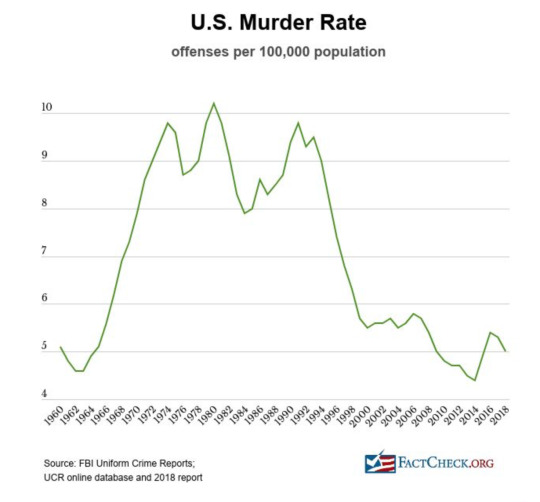
So basically, after a rough couple of decades, we’re back to where we were in 1960. But we’re actually much worse, because improvements in medical technology are keeping a lot of people that would’ve died 60 years ago alive. One paper from 2002 says that the murder rate would be 5 times higher if not for medical developments since 1960. I don’t know how much to trust this, but it’s surely true that we’ve made some medical progress since that time, and doctors have been getting a lot of experience from all the shooting victims they have treated over the decades. Moreover, we’re much richer than we were in 1960, and I’m sure spending on public safety has increased. With all that, we are now about tied with where we were almost three-quarters of a century ago, a massive failure.
What about psychology? As of 2016, there were 106,000 licensed psychologists in the US. I wish I could find data to compare to previous eras, but I don’t think anyone will argue against the idea that we have more mental health professionals and research psychologists than ever before. Are we getting mentally healthier? Here’s suicides in the US from 1981 to 2016
…
What about education? I’ll just defer to Freddie deBoer’s recent post on the topic, and Scott Alexander on how absurd the whole thing is.
Maybe there have been larger cultural and economic forces that it would be unfair to blame criminology, psychology, and education for. Despite no evidence we’re getting better at fighting crime, curing mental problems, or educating children, maybe other things have happened that have outweighed our gains in knowledge. Perhaps the experts are holding up the world on their shoulders, and if we hadn’t produced so many specialists over the years, thrown so much money at them, and gotten them to produce so many peer reviews papers, we’d see Middle Ages-levels of violence all across the country and no longer even be able to teach children to read. Like an Ayn Rand novel, if you just replaced the business tycoons with those whose work has withstood peer review.
Or you can just assume that expertise in these fields is fake. Even if there are some people doing good work, either they are outnumbered by those adding nothing or even subtracting from what we know, or our newly gained understanding is not being translated into better policies. Considering the extent to which government relies on experts, if the experts with power are doing things that are not defensible given the consensus in their fields, the larger community should make this known and shun those who are getting the policy questions so wrong. As in the case of the Afghanistan War, this has not happened, and those who fail in the policy world are still well regarded in their larger intellectual community.
…
Those opposed to cancel culture have taken up the mantle of “intellectual diversity” as a heuristic, but there’s nothing valuable about the concept itself. When I look at the people I’ve come to trust, they are diverse on some measures, but extremely homogenous on others. IQ and sensitivity to cost-benefit considerations seem to me to be unambiguous goods in figuring out what is true or what should be done in a policy area. You don’t add much to your understanding of the world by finding those with low IQs who can’t do cost-benefit analysis and adding them to the conversation.
One of the clearest examples of bias in academia and how intellectual diversity can make the conversation better is the work of Lee Jussim on stereotypes. Basically, a bunch of liberal academics went around saying “Conservatives believe in differences between groups, isn’t that terrible!” Lee Jussim, as someone who is relatively moderate, came along and said “Hey, let’s check to see whether they’re true!” This story is now used to make the case for intellectual diversity in the social sciences.
Yet it seems to me that isn’t the real lesson here. Imagine if, instead of Jussim coming forward and asking whether stereotypes are accurate, Osama bin Laden had decided to become a psychologist. He’d say “The problem with your research on stereotypes is that you do not praise Allah the all merciful at the beginning of all your papers.” If you added more feminist voices, they’d say something like “This research is problematic because it’s all done by men.” Neither of these perspectives contributes all that much. You’ve made the conversation more diverse, but dumber. The problem with psychology was a very specific one, in that liberals are particularly bad at recognizing obvious facts about race and sex. So yes, in that case the field could use more conservatives, not “more intellectual diversity,” which could just as easily make the field worse as make it better. And just because political psychology could use more conservative representation when discussing stereotypes doesn’t mean those on the right always add to the discussion rather than subtract from it. As many religious Republicans oppose the idea of evolution, we don’t need the “conservative” position to come and help add a new perspective to biology.
The upshot is intellectual diversity is a red herring, usually a thinly-veiled plea for more conservatives. Nobody is arguing for more Islamists, Nazis, or flat earthers in academia, and for good reason. People should just be honest about the ways in which liberals are wrong and leave it at that.
…
The failure in Afghanistan was mind-boggling. Perhaps never in the history of warfare had there been such a resource disparity between two sides, and the US-backed government couldn’t even last through the end of the American withdrawal. One can choose to understand this failure through a broad or narrow lens. Does it only tell us something about one particular war or is it a larger indictment of American foreign policy?
The main argument of this essay is we’re not thinking big enough. The American loss should be seen as a complete discrediting of the academic understanding of “expertise,” with its reliance on narrowly focused peer reviewed publications and subject matter knowledge as the way to understand the world. Although I don’t develop the argument here, I think I could make the case that expertise isn’t just fake, it actually makes you worse off because it gives you a higher level of certainty in your own wishful thinking. The Taliban probably did better by focusing their intellectual energies on interpreting the Holy Quran and taking a pragmatic approach to how they fought the war rather than proceeding with a prepackaged theory of how to engage in nation building, which for the West conveniently involved importing its own institutions.
A discussion of the practical implications of all this, or how we move from a world of specialization to one with better elites, is also for another day. For now, I’ll just emphasize that for those thinking of choosing an academic career to make universities or the peer review system function better, my advice is don’t. The conversation is much more interesting, meaningful, and oriented towards finding truth here on the outside.
11 notes
·
View notes
Note
DGS!!
Japanese trio + Barok!!!
Ryuu
1) Sexuality: Bisexual!
2) OTP: We all know it's Ryuususa lol <3
3) BroTP: I love his interactions with Sherlock, especially the dance of deductions! Those are my favorite parts of the game!
4) NoTP: I'm going to get a lot of flack for this omgggg As/Ryu/.... It's a lovely ship, I'm sure I would have loved it, but I've had some choice interactions with some of the more..... entitled..... fans, so it's just got a bitter taste in my mouth
5) Headcanon: The man is JACKED. So this is semi canon, but he's really in Kyudou, and I like to think that nobody thinks he would be due to his permanent baby face syndrome but he is JACKED
6) Second-Hand Embarrassment: That little "tap" he does when he's not confident, never fails to make me cackle
7) Relatable Moment: I relate to his impostor syndrome a lot, especially on my bad days, but despite it all, I try my best to power through, there's always a brighter day <3
8) Cinnamon Roll! ^-^
Susato
1) Sexuality: Bisexual because I project onto my faves lol
2) OTP: Ryuususa!
3) BroTP: I love her interactions with Iris! Not only is it a fangirl's dream, they also have those fun sister vibes, and I think it's really adorabl!
4) NoTP: More flack lmaooo Sus/Ha/, once again, entitled people have put an otherwise lovely ship on my "I would rather not" list
5) Headcanon: She gets to be an attorney in her own right! After years of activism, and debate, and proving herself, she gets to be an attorney with her own name!
6) Second-Hand Embarrassment: The Susato Takedown was funny the first few times, but then it started to get flanderized ^^"
7) Relatable Moment: I am a fangirl, and I really love the Sherlock Holmes stories (Baskervilles is my favorite!). I'm a huge bookworm, and I'm trying to get back into reading for fun!
8) CINNAMON ROLL
Kazuma
1) Sexuality: Queer
2) OTP: ..... I kind of have a crack ship but other than that, I don't really have an OTP for him lmaoo
3) BroTP: Ryuu's relationship is something that is so interesting to explore. They care for each other greatly, words can hardly describe it (I mean, I'm not BLIND, I see it all lol), and I really do think there's a lot I can explore there!
4) NoTP: As/Ryu/
5) Headcanon: Modern!AU Kazuma would SO be into the Steel Samurai, and unironically
6) Second-Hand Embarrassment: The way he treated Ryuu and Susato in the latter half of DGS 2.... they deserve to be mad because that treatment is unacceptable no matter what :T (He might actually be more chill in the localization, this is going off of the subbed playthrough I watched, so I might change my opinion)
7) Relatable Moment: I am also a rude bitch with floofy hair
8) Sinnamon Roll
Barok
1) Sexuality: Demiromantic Demisexual
2) OTP: Hell yeah I will do OC x Canon, because it's my blog and my sandbox and my barbie dolls to mash together! I'm very attatched and I hope to introduce this OC sometime in the near future when I get around to working on an AU I've been planning! If I had to choose canon, it's Sherlock, solely for the bitter ex boyfriend vibes XD
3) BroTP: Benjamin/Albert! I think he deserves an unhinged mad scientist friend... as a treat
4) NoTP: None really come to mind...? I guess Vortex x Barok? It's a really interesting ship, and an interesting dynamic, and I think anyone who writes for it is braver and more creative than me! ^-^
I guess NoTP is a little strong... I don't think I could do it justice, so it's kind of a "meh *shrug*" ship
5) Headcanon: He's left-handed, especially when you see where his sword is! He can write with his right-hand because Victorian Era schooling was just like that (tm), but he doesn't like it. He uses his right-hand for official documents, but his left for personal letters and notes!
6) Second-Hand Embarrassment: I mean, yeah, the racism. I think that's par for the course when you are a 21st century person looking in at a work that is supposed to take place over 100 years prior.
7) Relatable Moment: I, too, am a depressed ass goth ass bitch who desperately wants to be a vampire. In all seriousness, he's a very lonely character, and I do
relate to that a lot, especially with current events.... he reminds me of how I was during my hardest days, so I guess it's why he's a major comfort character for me.... granted I use him as my personal punching bag soooo there's that? XD
8) Problematic Fave (affectionate)
#ask#ask me things#ask me stuff#ask me anything#ask away#ask game#naruhodou ryuunosuke#ryuunosuke naruhodou#mikotoba susato#susato mikotoba#kazuma asougi#asougi kazuma#barok van zieks#tgaa spoilers#dgs spoilers#allie's dumb headcanons#no discourse please
11 notes
·
View notes
Text
Thanks to @onereyofstarlight for the tag!
1. What fandoms have you written for?
This is embarrassing but I actually had to look at both FFnet and AO3 because I couldn’t remember all of them. TRON: Legacy, Assassin’s Creed, Star Wars, Lord of the Rings and the Hobbit, Sherlock, Final Fantasy VII and XV and Kingsglaive, Voltron: Legendary Defender, Merlin, Skyrim, and, of course, Thunderbirds. I have a couple other fandoms that crop up in various wips, including a Tom Swift/Thunderbirds crossover that I really should finish.
2. How many works do you have on AO3 &/or FFNet?
FFnet has 45, and AO3 has 41. There’s also a couple stories lurking on tumblr, notably a final chapter for Reflection.
3. What are your top 3 fics by kudos on A03 &/or Favs on FFNet?
AO3 dominates in this area, if I can use a word like “dominates” for stories that have less than 125 kudos each haha. Oh well, the numbers don’t matter!
1. 118 kudos on tell the shades apart (my world is black and white)
2. 94 kudos on Reflection
3. 91 kudos on The 43rd Hour
4. Which 3 fics have the least kudos & Favs?
Again on AO3:
1 kudos on I Am You (And You Are Me)
5 kudos on The Dragonborn Chronicles
6 kudos on cynosure
5. Which Fic has the most comments and which has the least?
Reflection has the most at 29 threads, and I Am You (And You Are Me) has the least at zero.
6. Which complete fic do you wish had gotten more attention?
Lodestar, definitely. Sure, it’s for something of a rarepair, but they aren’t that rare, and I just really really like the way the story came together. On the other hand, of course my unfinished Merlin fic has gotten probably the most attention, because that’s just the way it goes, eh?
7. Have you written any crossovers?
None that I’ve published! I have various crossovers lurking in mostly unfinished states, including the aforementioned Tom Swift/Thunderbirds crossover, and an Assassin’s Creed/Thundeerbirds crossover that is very good and I should also finish. There’s an Expanse/Thunderbirds fic lurking in my brain that I may or may not ever commit to paper, who knows. I’ve also very vaguely toyed with a Batman/Thunderbirds crossover, in the sense that “nebulous” is too strong a word for the kind of toying I’ve been doing.
8. What is the craziest fic you’ve written?
I don’t really write crazy or crack or humor in general, so probably the closest thing to “crazy” is On the Lam, which was the result of wanting to throw Scott and Penelope toward an Egyptian stud farm. It ended up being the host for a bad joke about that, courtesy of one @thebaconsandwichofregret, who consistently gives some of the best dialogue advice I’ve ever encountered.
Actually, the true answer is probably a chapter in Glimpses into a Supernova, maybe the one about blood? It seems bonkers when I think back on it now, but I admittedly haven’t read it in many years. Possibly I am misremembering. Glimpses has some weird ones, though.
9. What’s the fic you’ve written with the saddest ending?
It’s a tossup between The Painting and a place where the water touches the sky. The former deals with a prior off-screen death; the latter is (maybe??) an on-screen death. People seemed upset by it, at any rate. I said it was ambiguous!
10. What’s the fic you’ve written with the happiest ending?
“Happy” is probably a matter of perspective? Depends on the overall reading experience and the ending within that context. Either septet or Three Towels and a Tracy, they’re both pretty fluffy overall.
11. What is your smuttiest fic?
protoinstincts, which I completely forgot I wrote and then rediscovered like a year later and realized “hey, this is actually pretty good” and you know what, despite it not being overly spicy, it is pretty good.
12. Have you ever received hate on a fic?
Not hate, per se, but someone left a review on Less Than Nothing saying they “didn’t like” that I “wrote the story as a series of drabbles.” Cool, I didn’t write the story for you, random guest reader, and the back button exists, friend 😂 It didn’t bother me on a personal level because I wrote the fic for an audience of one (incidentally, not myself and rather the recipient of a secret santa event), but I was mad because the reviewer had no way of knowing where I was at as a writer, and I know from longtime observation how that kind of comment can crush less experienced or confident writers.
Don’t leave flames, kids, you don’t understand the power your words have. Don’t like, don’t read.
13. What is the nicest comment you’ve received?
The nicest? Goodness. Hmm. I’d have to go hunting to find the nicest, but in recent memory, @ayzrules sent me a couple passages from Spanish texts she’s been studying that reminded her of my writing, and I was honestly so touched by the fact that she even thought to make such comparisons, much less mention them to me. Taking the time to familiarize yourself with someone’s style until you can make comparisons between it and someone else’s work is so much more meaningful to me personally than a basic “Nice story!” or “Loved this!” type of comment ever could be. <3 Ayz <3
14. Have you ever had a fic stolen?
Not that I’m aware of, but I’ve never gone looking on any sort of copycat site or whatever either.
15. How many fics do you have marked as incomplete?
Two. First is The Dragonborn Chronicles, which is a retelling of Skyrim from Lydia’s perspective via her journal, to complement the in-game journal. It’s a slog of a style to write, though, even for someone who loves writing first person and doesn’t really want to write a lot of dialogue, and the outline is huge, and the story will be many times more huge, and just. Some day. Some day.
Second is tell the shades apart (my world is black and white), which has always been unfinished because the outline itself is over seven thousand words and the fully written story would undoubtedly land between 100,000 and 200,000 words, and there’s no way I’m writing that. I’ve always meant to upload the outline, but I got kind of self-conscious about the way I formatted it, and ugh I just haven’t bothered. One day, one day, right?
Moral of the story is I’m intensely a short story writer, and I’ve really found myself settling into that role over the last couple years. Better a clipped, punchy short story than a bloated slog of an epic.
16. Which of the WIPS will most likely be finished first?
Literally no one knows that. I wrote 95% of the observable entropy of a closed system over five years ago, and then I proceeded to pull it out roughly once a year and write and rewrite various endings until last month, which was when I finally figured out how I wanted to end the story. septet, too, languished for about five years before I finally remembered it existed and managed to wrangle an ending. Endings are hard, man. So are those third plot points. Terrible creatures, those, bog me down every time.
17. Which WIP are you looking forward to finishing?
Uh... mm. See. If I were looking forward to finishing any of them, I’d be actively working on them. At this moment, writing fic isn’t exactly high on my list of priorities, but I am also coming off a four-day idle game bender, so I still feel like I haven’t quite reengaged with myself as a living person. Give me another few days and I might have an answer.
(I am always most looking forward to finishing this ridiculous Ignis-drives-the-Audi-R8 fic that’s been languishing in my wips for literal years. As mentioned above, third plot points. Killer, man.)
(oh and also the working-titled the art of murder. Scott and Penny attend a private art auction. Things don’t go to plan. It, too, is stuck at the third plot point. I know, I know I have a problem, shush.)
18. Is there a WIP that you’re considering abandoning?
Any wip has the potential to be revived—this year and the old wips I’ve unearthed, dusted off, finished, and posted have been proof of that. I don’t intentionally permanently abandon anything for that reason, some stories just probably will remain dusty old wips forever because I didn’t actually need or want to write the full story for one reason or another.
19. Which complete fic would you consider rewriting?
Now that’s an interesting question. Hmm! Honestly? None of them. Once I finish a story, I’m not inclined toward rereading it again any time soon, to the point of years in some cases, and I feel like I’ve moved on from the stories I wrote one, two, five, eight years ago in the actual writing sense. They’re finished stories, and on top of that are relics of their time, which doesn’t mean the stories don’t have any ongoing significance on a reading level—I just don’t have any interest in rewriting those particular stories. I’ve gotten them out of my head, to the point of not remembering at least a third of them on demand anymore, and I don’t have any desire to “retell” those exact stories. I do tend to tighten the wording and fix perceived errors/weaknesses whenever I do end up rereading an old story, and I usually silently update the AO3 version if I make any significant changes because AO3 makes it a breeze to update a posted fic. I might do FFnet too if I’m feeling up to it or have the time.
20. Which complete fic is your favourite?
Once upon a time I would’ve said Holding On, but I honestly find it kind of unbearably melodramatic now. the observable entropy of a closed system is equally melodramatic, as it was written in the same era, but at least it has the excuse of being told in second person and via a style that is a half step away from being poetry. Possibly I will reread it in a few years and find it equally obnoxious and overly dramatic, but it received some shockingly positive comments, which I wasn’t expecting at ALL, and I’ve been honestly blown away by the amount of praise it’s received. <3 to everyone who’s said anything about it!
21. What’s your total published word count?
141,000 on AO3, 160,000 on FFnet, but technically the light of my life SS wrote fifty thousand words of each. It’s too late for math.
I tag @velkynkarma, @lurkinglurkerwholurks, @writtenbyrain, @thebaconsandwichofregret, and anyone else who wants to play!
6 notes
·
View notes
Text
Building a Viable Future in Destiny 2
TL;DR
Destiny 2 is too large to efficiently update and maintain.
The size and complexity of the game are also contributing to more bugs and less innovation.
Instead of building a Destiny 3 and leaving D2 behind, each year, we are going to cycle older, less actively played content out of the live game and into what we’re calling the Destiny Content Vault (DCV).
This will allow us to add to and support D2 for years, including the three new annual expansions we announced today, starting with Beyond Light this fall.
The DCV will include all content from Destiny 1 and anything that cycles out from Destiny 2.
We will bring back (or “unvault”) activity and destination content from the DCV each year.
Unvaulting starts in D2 Year 4, with the Cosmodrome coming back, as well as its three strikes and the return of the Vault of Glass raid.
The primary D2 content leaving the game and going into the DCV this fall are the destinations – Mars, Io, Titan, Mercury and Leviathan – and their supported activities.
There will be new ways to earn the Exotics originally linked to content that has entered the DCV.
When Beyond Light ships, the Director will have the following destinations:
Europa (new)
Cosmodrome (unvaulted)
Moon
Tangled Shore
Dreaming City
European Dead Zone
Nessus
This approach allows us respond to player feedback more rapidly, enable more innovation, and will keep Destiny 2 and your characters thriving for years to come
.More details to come soon and throughout the year.
Building a Viable Future in Destiny 2
Earlier today, we laid out a vision for Destiny's future, built right inside of Destiny 2. A future where we maintain your characters, accounts, and continuity with our game systems and build on each of them for years. This fall ushers in a new era in Destiny's journey, launching off a trilogy of expansions where your Guardians will explore the true nature of Light and Dark:

Put plainly, we are investing in Destiny 2 for years to come. But to continue your Guardian’s journey and deliver on this roadmap, we need to make some changes to our ever-growing world so it can flourish.
THE LIMITS OF GROWTH
Over the past couple months, we’ve mentioned the problems that come with maintaining a game the size of Destiny 2; and we’ve said that it cannot grow infinitely. After three years of non-stop growth, the scope and complexity of Destiny 2 has ballooned to unprecedented scale.
As of this writing, Destiny 2 features nine destinations, 40 story missions, 54 adventures, 42 Lost Sectors, 17 strikes, 31 PvP maps, 12 one-off special activities (like Menagerie or Zero Hour), seven raids, six Gambit arenas, three dungeons, many, many quests, patrols, public events, and of course, thousands of associated rewards. All of that, plus hundreds of game systems which layer on top of that content.
This unrelenting growth has resulted in a game that requires players to download up to 115GB to play, as well as huge patches tied to frequent updates. And those numbers are rising rapidly, as we’ve been adding approximately 25GB of content each year to Destiny 2 since launch. Those sizes not only stress hard drive capacity but also push the limits of patching capability. It also makes the time to generate a stable update for the game after all content is finalized, tested, and ready to go balloon to literal days instead of hours.
Worse still, that 115GB includes a lot of content that isn't relevant anymore – and can't remain relevant – as we evolve the world and introduce new experiences that will take center stage instead. For example: Warmind’s campaign represents only 0.3% of all time played in Season of the Worthy and yet the Warmind Expansion accounts for 5% of our total install size. This dramatic imbalance between player engagement and overall cost to maintain is found in a lot of our legacy content.
IMPACT ON THE LIVE GAME
Maintaining that much content in perpetuity slows down our ability to update the game with fresh experiences, reduces our ability to innovate, and delays our reaction to community feedback. The test surface alone is massive, to say nothing about how it impacts our designers, artists, and engineers trying to make cool new stuff every day under the weight of the crushing complexity of our scale.
Unfortunately it also means that we sometimes ship content that doesn’t meet the quality bar we’ve set for ourselves and that our players have come to expect. Recent examples are the issues with Felwinter’s Lie quest or when we had to perform our first-ever rollback of player progress due to a bug.
Our ambition is for Destiny 2 to be the best Action MMO in the world and that means being far more agile and nimble than we are today. But the simple fact is that our game's size and complexity prevents us from improving Destiny as fast as we – and you – would like.
THE “DESTINY CONTENT VAULT”
With Destiny 1, we solved the “ever expanding, exponential complexity” problem by making a sequel in Destiny 2. We left behind all of Destiny 1’s content and many of the features players grew to love. We believe now that it was a mistake to create a situation that fractured the community, reset player progress, and set the player experience back in ways that took us a full year to recover from and repair. It’s a mistake we don’t want to repeat by making a Destiny 3. We don't believe a sequel is the right direction for the game and for the past two years we have been investing all of our development effort into new content, gameplay, and new engine features that directly support a single evolving world in Destiny 2.
To create a sustainable ecosystem where the world can continue to evolve in exciting ways, and where we can update the game more quickly, we're going to adopt a new content model that we're calling the
Destiny Content Vault (DCV)
. Each year, usually at the expansion boundaries, we will cycle some destination and activity content out of the game (and into the DCV) to make room for new experiences.
The first cycle of Destiny 2 content going into the DCV begins this fall, with the appearance of the Pyramid ships in Season of Arrivals and the Beyond Light expansion, which we revealed today. Those events will usher in dramatic changes to the Destiny universe, affecting characters, destinations, and Guardians for years to come.
To set a new maintainable foundation for the game this fall and to create room for Beyond Light and the future roadmap, the first Destiny 2 deposit into the DCV will be larger than those to come in the future.
CURATING THE VAULT
Content that goes into the Destiny Content Vault may return in the future, altered (if necessary) to fit the new state of the universe. Furthermore, we consider all Destiny 1 and 2 destinations and activities part of the new DCV and we’re going to be pulling from that archive – revisiting some of the most interesting places in Destiny’s history – from now onwards. It’s why the original Destiny 1 Raid – the Vault of Glass – will be returning to Destiny 2 in Year 4.
Going forward, our explicit goal will be to try to keep the scope and scale of Destiny 2 at a relatively consistent size in order to increase our agility and to be able to properly support and maintain the game. Over the course of each year, the game’s content scope will grow as we add new destinations and activities in our expansions and Seasons. As we approach the next expansion, another cycle of content will go into the DCV to make way for a new influx of destinations and activities.
We will always do our best to give early notice of what's being cycled into the DCV, to help you and your friends plan around how you want to complete your collections and build up your account before the new Destiny year starts. The vast majority of content we choose to vault will also be from destinations and activities that have been free for all players for several months prior to their departure. For example: the Curse of Osiris campaign, which has been free since Shadowkeep launched in October 2019, and part of the Destiny 2 experience since December 2017, will go in the DCV later this year.
YEAR 4 DESTINY CONTENT VAULT PREVIEW
Here is an early preview of some of what’s going into the Destiny Content Vault (DCV) and what’s returning in Year 4.
RETURNING FROM THE DCV
On September 22, 2020:
Cosmodrome as a selectable, explorable destination (but not yet at full Destiny 1 parity on 9/22).
Note: We’re looking to leverage Cosmodrome’s initial return to expand the new Guardian origin story to the world of Destiny. Veteran players will be able to experience that story as well.
Cosmodrome’s Will of Crota strike will also be added to the strikes playlist for all players.
During Season 13:
Cosmodrome will be fleshed out to roughly Destiny 1 Year 1 parity.
Cosmodrome’s The Devil’s Lair and Fallen S.A.B.E.R. strikes return.
During Year 4:
Destiny 1’s first raid, Vault of Glass, returns.
HEADING TO THE DCV
On September 22, 2020:
Io, Titan, Mercury, Mars, and Leviathan will be cycled out and no longer be accessible.
This includes all PvE activities (including campaigns) on those destinations.

OTHER KEY YEAR 4 DETAILS:
There will be three raids playable this fall, including a new one set in the Deep Stone Crypt on Europa as part of the Beyond Light expansion.
There will be new ways to earn Exotics originally tied to destinations and activity content that have entered the Destiny Content Vault.
Available strikes will be based on a pool of possible strikes from active destinations. When a destination goes into the DCV, so too will its strikes.
The PvP Map playlist will remain a curated ‘best of’ mixture of maps from Destiny 1 and 2.
Gambit and Gambit Prime are being merged into a single mode, with their original armor visuals available to earn from the Drifter.
To be clear, the DCV does not apply to any weapons and armor in a player's inventory or vault. The DCV is about activities and destinations. We know you will have a lot of questions about how this will work. We will share more updates about our content plans throughout the summer. This includes a detailed overview of everything changing via patch notes, extensive DPS articles that will help break down what’s changing and when, as well as lots of opportunities for you to ask us questions along the way.
A NEW BEGINNING
This fall, we will begin delivering on the future of Destiny by making way for new adventures, locales, and stories dreamed up by our creative team, and forging the truly evolving world that it was always meant to be. These changes allow us the freedom to finally weave an overall experience for the Destiny universe that can truly live, starting with Beyond Light. We can now fit puzzle pieces we haven’t been able to pick up since the beginning of the original Destiny – including the true nature of the Darkness and Light and how such power will change you as a Guardian. We can now bring some of the greatest experiences in Destiny to the forefront of the current game alongside new ones to come.
The past six years, we’ve seen the Destiny universe grow and our community along with it. We want our quality of service to grow in kind, to be able to react to community feedback quicker, to innovate more often, and to continue to tell new stories with your characters. We’re excited to continue that journey with you.
– Destiny 2 Dev Team
161 notes
·
View notes
Photo



The 1990s Moments That Changed the Way We Think About Food
By: Anna Hezel Illustrations: Ellie Skrzat
The ’90s were a decade of information, SnackWell’s, and sun-dried tomatoes on everything. Here are eight events that shaped our opinions about cooking and eating.
1. The Launch of the TV Food Network
In April of 1993, a young and scrappy Food Network launched with a debut lineup of French chef Jacques Pepin, writer David Rosengarten, Mrs. Fields founder Debbi Fields, and Emeril Lagasse, a little-known Louisiana restaurateur in his mid-30s with only a handful of prior television appearances under his belt.
Dorie Greenspan, who worked at the network during its launch as a consultant and producer, remembers it as a pioneering time in the unexplored realm of food television. On the TASTE Podcast, Greenspan recalled the head of programming at the time saying, “We’re going to make somebody a star, but we don’t know who that person will be.” It swiftly became clear that Emeril was that star.
In addition to the runaway hits, like Essence of Emeril, there were misgivings during the launch. “This was really a startup in every sense of the word,” she told me. “We made some terrible mistakes. We couldn’t figure out a bunch of things. We tried doing a call-in show, which seemed revolutionary. We were learning.”
The only model the network had at the time for programming about cooking was public television—shows like James Beard’s I Love to Eat and Julia Child’s The French Chef. But the move to cable meant a move toward the mainstream. “I don’t think you can underestimate the impact of that,” says Ruth Reichl. “That’s the moment that food really stopped being the provenance of the elites and became part of popular culture. Children watched it and were interested in chefs, and chefs became cool in a way that they hadn’t before.”
2. Fat Is Bad, But Everything Else Is Good
At the tail end of the ’80s, a few influential government reports were published, recommending that Americans consume less fat. Americans internalized this as a directive that it was OK to consume as many calories as they wanted, as long as those calories weren’t coming from fat. A zany infomercial nutritionist named Susan Powter encouraged Americans to fill their shopping carts with cereal and low-fat chips, and SnackWell’s were born, promising unlimited amounts of dessert with no health repercussions.
Lay’s launched one of the most famous product missteps in the history of American consumerism. WOW chips, introduced in 1998, promised the same potato chip flavor with only one gram of fat per serving—a feat made possible by frying in a synthetic fat substitute called Olestra. Almost as soon as the chips hit the market, accounts started to pour in of horrible stomach woes caused by the chips. The FDA famously used the phrase “anal leakage” to describe the side effects, leading to one of the grossest and most memorable PR disasters in the history of packaged foods.
3. Sushi Goes Mainstream
By the ’90s, sushi had existed in the United States for more than three decades, but this was the moment when it really caught on, especially as Japanese companies opened offices in U.S. cities. “It all started when Sony bought Columbia Pictures in 1989 and the entire West Coast went mad for sushi,” speculates Alan Richman, who was the restaurant critic at GQ at the time.
Everyone started opening sushi restaurants, including Robert DeNiro with a then little-known chef named Nobuyuki Matsuhisa, and in turn, sushi evolved from a rarefied luxury that one could only find in coastal cities to a casual, affordable treat that happened to fit perfectly into the era’s philosophy about nutrition. And then grocery stores started to catch on, stocking their refrigerator cases with plastic trays of California and spicy tuna rolls.
4. The Dawn of Online Recipes
When we talk about the kind of rapid globalization that happened in the ’90s, it’s hard to avoid talking about the Internet, which shattered our spatial relationships to one another by making it as easy to talk to someone in Australia as it was to talk to the kid in your social studies class who lived down the street.
As the Internet became woven into our daily lives through services like Prodigy and America Online, it was only a matter of time before this rapidly growing technology became a way to disseminate the recipes and cooking advice that you could previously find only in magazines and cookbooks.
In 1995, Condé Nast launched Epicurious, a forward-thinking database of recipes compiled from some of the company’s food and travel magazines, including Bon Appétit and Gourmet. By the end of the decade, blogging platforms like Blogger and Xanga had emerged, paving the way for a generation of self-publishing food bloggers, like David Lebovitz in 1999, and Heidi Swanson, Pim Techamuanvivit, and Clotilde Dusoulier in the early 2000s.
5. A New Era for Restaurant Critics
“I think the ’90s were the great era of restaurants in America,” says Alan Richman. The economy was strong, people had money to spend, and newspapers and magazines had budgets to send their critics to eat out and report on the latest trends in food. Fine-dining stalwarts in New York, like Le Bernardin, Daniel, and Jean-Georges, were thriving. But it was also a time when critics like Robert Sietsema at the Village Voice and Ruth Reichl at The New York Times started to clue diners in to the fact that “eating out” didn’t always have to mean French restaurants with white tablecloths.
“I was interested in talking about the way real people ate,” says Reichl. “I felt like restaurant reviews in The New York Times had been geared to a very small group of wealthy white people. And I thought everybody should go to restaurants.”
When Reichl reviewed her first Korean restaurant, Kang Suh, in 1993, three separate local Korean newspapers from New York reached out to her for interviews. When she wrote about a soba restaurant called Honmura An that same year, it caused a flap among readers who weren’t used to seeing “a little Japanese noodle shop” receive three stars.
6. NAFTA Reshapes California’s Food Landscape
In 1994, NAFTA (the North American Free Trade Agreement) was signed, formalizing a trade agreement among Canada, Mexico, and the United States. As Tina Vasquez writes, the agreement was greeted with lots of anti-immigrant pushback among Americans. Carlos Salinas de Gortari, the Mexican president at the time, promised Americans that the agreement would reduce migration by stabilizing Mexico’s economy.
Instead, the agreement caused vast unemployment in Mexican industries that struggled with their new competition, leading to one of the largest historic spikes in immigration to the United States from Mexico. This brought a boom of Mexican grocery stores, butchers, restaurants, and other businesses to the U.S., especially in Californian communities like the Bay Area and Los Angeles. Grocery store chains like Chavez Supermarkets, Vallarta Market, and Northgate González are still thriving in these parts of the state.
7. Italian Food Goes Regional
In my house, in a suburb of Buffalo, New York, the ’90s was the era when the green Kraft canister of Parmesan cheese in the refrigerator was replaced with a little plastic-wrapped triangle of hard cheese and a hand-crank cheese grater. Starbucks and Olive Garden (which were founded in the ’70s and ’80s, respectively) were starting to make their way into every suburb, and Americans were warming up to the idea of saying “venti” out loud.
Marcella Hazan, Italy’s Julia Child, published The Essentials of Italian Cooking in 1992, and Molto Mario (starring Mario Batali before he had been accused of sexual assault) first aired in 1996. Americans were coming to terms with the fact that Italian food was more than a plate of spaghetti and meatballs—it was a cuisine with discrete regions, like Piedmont and Emilia-Romagna. And of course, every chef and home cook in America started putting sun-dried tomatoes on everything.
8. The Collapse of the Soviet Union Rewrites the World Map
When the Soviet Union ended in 1991, the entire world map changed. Countries that hadn’t had a spot on the spinning globe in decades reemerged, and a few altogether new ones were formed. Suddenly, trade opened up between these countries and the rest of the world, spurring a period of wild, unregulated capitalism. Soviet-government-owned food-manufacturing companies started going out of business.
“Everyone wanted pizza, and later in the ’90s sushi, and there was this huge flood of new, very shoddy quality global foods, to which most people didn’t have access because the prices weren’t regulated,” says Anya Von Bremzen, the author of Please to the Table and Mastering the Art of Soviet Cooking. “It’s a decade that’s remembered really negatively in that former Soviet bloc.”
The dissolution of the USSR also increased immigration to the U.S. from former Soviet countries. Cuba, which had been a close ally of the Soviet Union, was plunged into an economic depression, during which lack of ingredients lead to a loss of traditional Cuban cuisine.
On a broader level, as Von Bremzen points out, this large-scale globalization was the start of another very ’90s concept: nostalgia for all things regional.
https://www.tastecooking.com/1990s-moments-changed-way-think-food/?utm_source=pocket-newtab
Recipes: https://www.tastecooking.com/recipes/
Most Recent features
Calamari in Crisis February 2, 2021
Hetty McKinnon and the Quiet Power of Tomato and Egg February 1, 2021
Got Milk? Make Salsa.
7 notes
·
View notes